Half-Life for Posts on Different Social Media Platforms
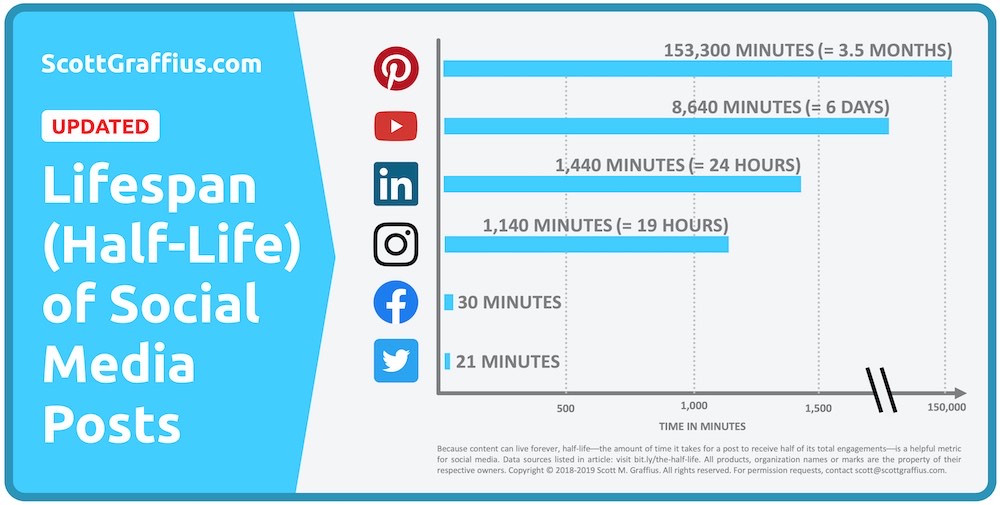

If there are any supplements or updates to this article after the date of publication, they will appear in the Post-Publication Notes section at the end of this article.

Social media is one of the most important aspects of digital marketing. Well-executed, it provides several benefits: improved brand and marketplace awareness, engagement with a worldwide audience, increased traffic, enhanced search engine optimization (SEO) rankings, and more.
The lifespan of posts is of interest. Because content can live forever, a more helpful metric is half-life. It’s the amount of time it takes for a post to receive half of its total engagements. As shown in the image above and described below, the half-life of posts varies by platform.

- Half-life for posts: 21 minutes
- References: https://moz.com/blog/when-is-my-tweets-prime-of-life and https://blog.hootsuite.com/twitter-statistics/
- Half-life for posts: 30 minutes
- Reference: http://www.wiselytics.com/blog/facebook-posts-lifetime-even-shorter-than-you-thought/
- Half-life for posts 1,140 minutes (= 19 hours)
- Reference: https://get.simplymeasured.com/2014-q4-instagram-study.html#sm.00010ubysp4k5cujr2e2hdhgkg67l
- Half-life for posts: 1,440 minutes (= 24 hours)
- Reference: https://espirian.co.uk/linkedin-improve-engagement/
YouTube
- Half-life for videos: 8,640 minutes (= 6 days)
- Reference: http://www.businessinsider.com/chart-of-the-day-the-lifecycle-of-a-youtube-video-2010-5
- Half-life for posts: 153,300 minutes (= 3.5 months)
- Reference: https://www.webfx.com/blog/social-media/why-pinterest-better-than-facebook-brands/

Be mindful of the half-life values when posting content.

Post-Publication Notes
Update on 6 January 2025
Algorithms and other factors on social media platforms change over time. For that reason, Scott M. Graffius periodically updates his 'Lifespan (Half-Life) of Social Media Posts' research. The most current edition is here.

© Copyright 2018 Scott M. Graffius. All rights reserved. This material may not be published, broadcast, rewritten or redistributed without the express written permission of Scott M. Graffius.

Four Ways to Improve Your Strategic Thinking Skills Today

Strategic thinking is often considered essential to an organization's successful performance. Some have even advocated for companies to develop the strategic thinking skills of their executives and other staff as a core competency. How can strategic thinking skills be developed? But first, here's a definition.
“Strategic thinking is a distinctive management activity whose purpose is to discover novel, imaginative strategies which can rewrite the rules of the competitive game; and to envision potential futures significantly different from the present. Furthermore, strategic thinking is specified as being conceptual, systems-oriented, directional (linking the future with the past), and opportunistic.”
— Ellen F. Goldman
In other words, strategic thinking is a process used to broaden an individual's perspective to achieve successful outcomes such as competitive advantage. And it can happen at every level of the organization; it's not just for executives.
Here are four specific things you can do to improve your strategic thinking skills.
1. Schedule Time for Strategic Thinking
You are investing in your success as well as that of the organization. Find the time to focus on strategic thinking. A tip is to place a recurring event on your calendar to reserve time for strategic thinking activities.
2. Monitor the Big Picture Including Trends
The default focus at most organizations is on what’s directly ahead. However, "peripheral vision"—including keeping sight of the big picture and industry trends—is essential for long-term success. Some tips follow. Keep abreast of industry organizations and publications. Build external networks to help you best scan the competitive landscape. Determine the unique perspective that your role provides, and define its favorable impact on the organization’s vision, mission, and/or strategic objectives.
3. Ask Questions to Uncover Patterns
Further to your mindfulness of the big picture and understanding of changes in the industry, you can put strategic thinking to work by asking yourself and others questions. A few examples follow. "What if _____?" questions are frequently effective in helping one "see around the corner." And variations such as "If _____, then _____?" often yield insights as well.
4. Embrace Uncertainty and Conflict
Strategic thinking involves envisioning the future and potential proactive ways the organization can change to remain competitive and successful. You should accept that the future is uncertain, and challenging assumptions by asking questions and other tactics may make some people uncomfortable. Remaining mindful of those aspects will help you stay the course in regularly practicing strategic thinking and securing the benefits summarized in this article.
Conclusion
By sharpening your strategic thinking skills, you benefit both yourself and your organization. It helps you make a greater contribution to the business—which may also support your advancement—and it helps the company enjoy greater competitive advantage and long-term success. So, start work on your strategic thinking skills today!

Bibliography
Atsmon, Yuval (2017, May 2). How to Unleash Your Strategic Thinking. Digital article. McKinsey & Company.
Bonn, Ingrid (2005, June). Improving Strategic Thinking: A Multilevel Approach. Leadership & Organization Development Journal, 26 (5). DOI: 10.1108/01437730510607844.
Cowan, N. (2001, February). The Magical Number 4 in Short-Term Memory: A Reconsideration of Mental Storage Capacity. Behavioral and Brain Sciences, 24 (1): 87-119.
Dixit, Avinash K. and Nelebuff, Barry J. (1993). Thinking Strategically: The Competitive Edge in Business, Politics, and Everyday Life. New York, NY: W. W. Norton & Company.
Goldman, Ellen F. (2007, Summer). Strategic Thinking at the Top. MIT Sloan Management Review, 48 (4): 75-81.
Graffius, Scott M. (2016). Thinking Strategically and Acting Tactically. Winnetka, CA: Exceptional PPM and PMO Solutions.
Reynolds, K. (2013). Strategic Thinking for Today's Project Managers. Paper presented at PMI Global Congress 2013—North America, New Orleans, LA. Newtown Square, PA: Project Management Institute.
Syrett, Michael and Devine, Marion (2012). Managing Uncertainty: Strategies for Surviving and Thriving in Turbulent Times. London, United Kingdom: Profile Books.

About the Author

Scott M. Graffius is an agile project management consultant, practitioner, award-winning author, and keynote speaker. Content from his books, speaking engagements, and more has been used by businesses, governments, and universities, including Gartner, Cisco, RSA, Ford, Qantas, Atlassian, Bayer, the United States Department of Energy, the New Zealand Ministry of Education, Tufts University, Texas A&M, and others. Thinkers360 named Scott a Top 20 Global Thought Leader and Influencer.
His full bio is available here.
Connect with Scott on:
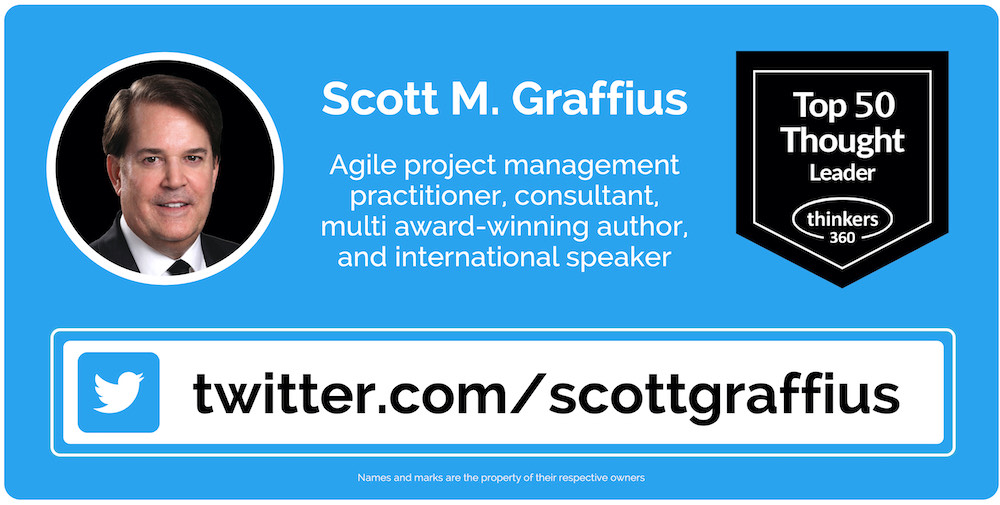

About Agile Scrum: Your Quick Start Guide with Step-by-Step Instructions
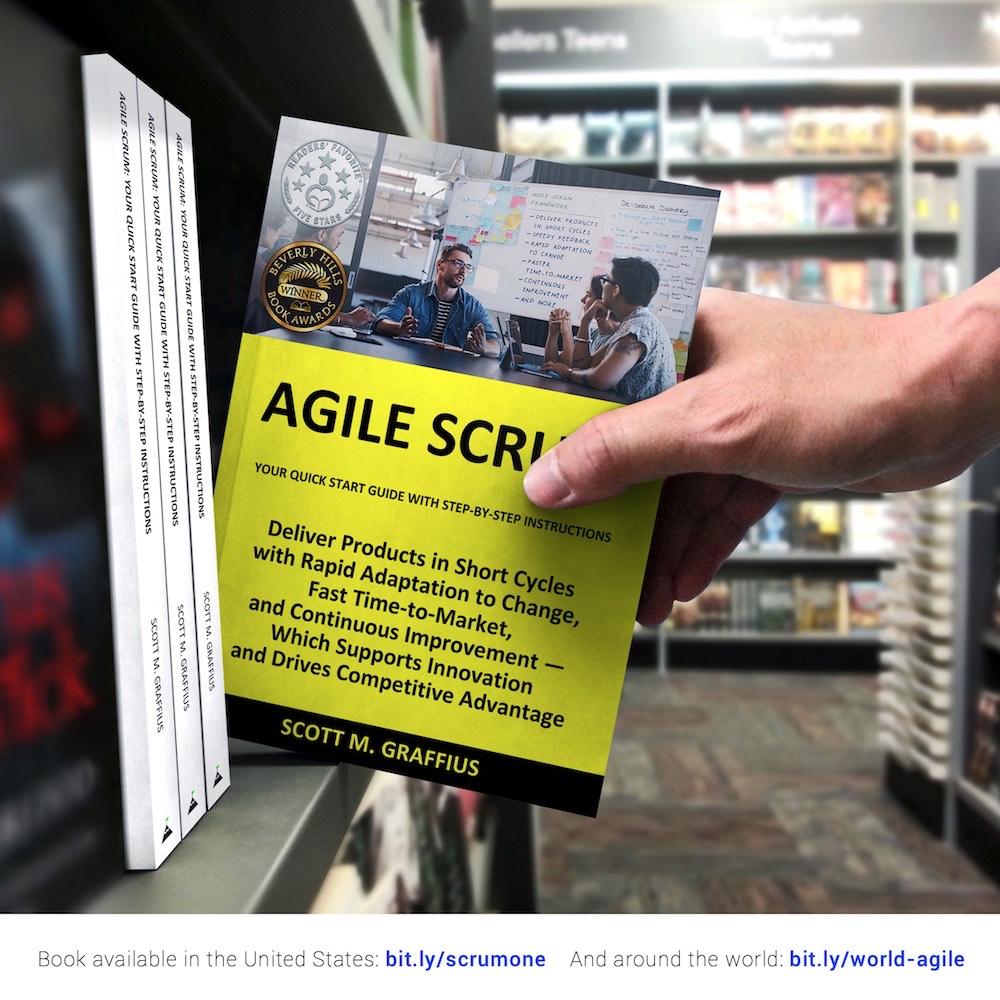
Shifting customer needs are common in today's marketplace. Businesses must be adaptive and responsive to change while delivering an exceptional customer experience to be competitive.
There are a variety of frameworks supporting the development of products and services, and most approaches fall into one of two broad categories: traditional or agile. Traditional practices such as waterfall engage sequential development, while agile involves iterative and incremental deliverables. Organizations are increasingly embracing agile to manage projects, and best meet their business needs of rapid response to change, fast delivery speed, and more.
With clear and easy to follow step-by-step instructions, Scott M. Graffius's award-winning Agile Scrum: Your Quick Start Guide with Step-by-Step Instructions helps the reader:
- Implement and use the most popular agile framework―Scrum;
- Deliver products in short cycles with rapid adaptation to change, fast time-to-market, and continuous improvement; and
- Support innovation and drive competitive advantage.
Hailed by Literary Titan as “the book highlights the versatility of Scrum beautifully.”
Winner of 17 first place awards.
Agile Scrum: Your Quick Start Guide with Step-by-Step Instructions is available in paperback and ebook/Kindle in the United States and around the world. Some links by country follow.
- 🇧🇷 Brazil
- 🇨🇦 Canada
- 🇨🇿 Czech Republic
- 🇩🇰 Denmark
- 🇫🇮 Finland
- 🇫🇷 France
- 🇩🇪 Germany
- 🇬🇷 Greece
- 🇭🇺 Hungary
- 🇮🇳 India
- 🇮🇪 Ireland
- 🇮🇱 Israel
- 🇮🇹 Italy
- 🇯🇵 Japan
- 🇱🇺 Luxembourg
- 🇲🇽 Mexico
- 🇳🇱 Netherlands
- 🇳🇿 New Zealand
- 🇳🇴 Norway
- 🇪🇸 Spain
- 🇸🇪 Sweden
- 🇨🇭 Switzerland
- 🇦🇪 UAE
- 🇬🇧 United Kingdom
- 🇺🇸 United States

About Agile Transformation: A Brief Story of How an Entertainment Company Developed New Capabilities and Unlocked Business Agility to Thrive in an Era of Rapid Change

Thriving in today's marketplace frequently depends on making a transformation to become more agile. Those successful in the transition enjoy faster delivery speed and ROI, higher satisfaction, continuous improvement, and additional benefits.
Based on actual events, Agile Transformation: A Brief Story of How an Entertainment Company Developed New Capabilities and Unlocked Business Agility to Thrive in an Era of Rapid Change provides a quick (60-90 minute) read about a successful agile transformation at a multinational entertainment and media company, told from the author's perspective as an agile coach.
The award-winning book by Scott M. Graffius is available in paperback and ebook/Kindle in the United States and around the world. Some links by country follow.
- 🇦🇺 Australia
- 🇦🇹 Austria
- 🇧🇷 Brazil
- 🇨🇦 Canada
- 🇨🇿 Czech Republic
- 🇩🇰 Denmark
- 🇫🇮 Finland
- 🇫🇷 France
- 🇩🇪 Germany
- 🇬🇷 Greece
- 🇮🇳 India
- 🇮🇪 Ireland
- 🇯🇵 Japan
- 🇱🇺 Luxembourg
- 🇲🇽 Mexico
- 🇳🇱 Netherlands
- 🇳🇿 New Zealand
- 🇪🇸 Spain
- 🇸🇪 Sweden
- 🇨🇭 Switzerland
- 🇦🇪 United Arab Emirates
- 🇬🇧 United Kingdom
- 🇺🇸 United States

The short link for this article is https://bit.ly/4-strategic.
This article was first published here. Later—on August 24, 2021—the article was posted to LinkedIn here as well.

© Copyright 2020 Scott M. Graffius. All rights reserved. This material may not be published, broadcast, rewritten or redistributed without the express written permission of Scott M. Graffius.

Lifespan (Half-Life) of Social Media Posts: Update for 2021
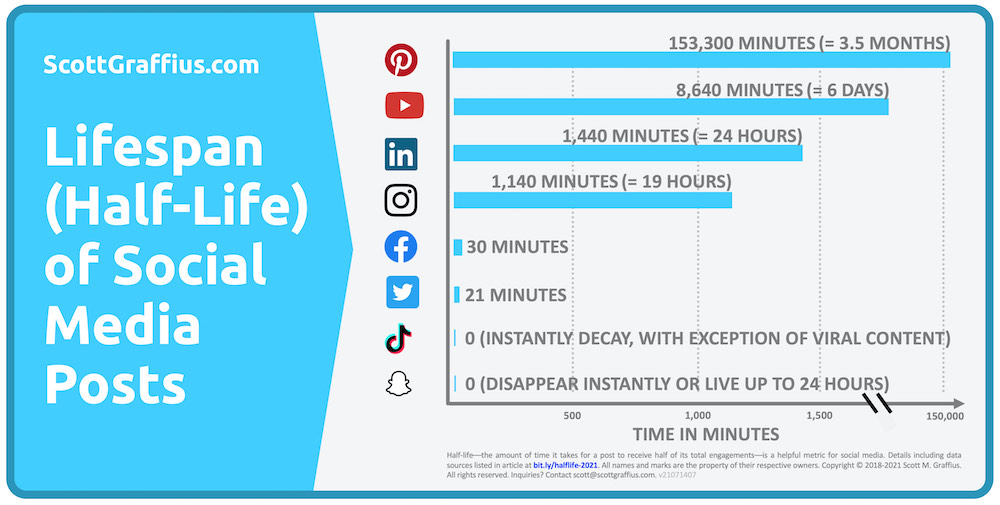

If there are any supplements or updates to this article after the date of publication, they will appear in the Post-Publication Notes section at the end of this article.

2021 Update
Social media marketing (SMM) is one of the most important aspects of digital marketing. It involves creating and sharing content on social media networks in order to advance business objectives such as marketing and branding goals. Well-executed, it provides several benefits: improved brand and marketplace awareness, engagement with a worldwide audience, increased traffic, enhanced search engine optimization (SEO) rankings, and more.
The lifespan of posts is of interest. Because content can live forever, a helpful metric is half-life. It’s the amount of time it takes for a post to receive half of its total engagements. As shown in the image above and described below, the half-life of posts varies by platform.
Earlier versions of this article and the associated visual covered six platforms: Pinterest, YouTube, LinkedIn, Instagram, Facebook, and Twitter. This update addresses those six platforms, and two additional ones: TikTok and Snapchat.
- Half-life for posts: 21 minutes
- References: https://moz.com/blog/when-is-my-tweets-prime-of-life and https://blog.hootsuite.com/twitter-statistics/
- Half-life for posts: 30 minutes
- Reference: http://www.wiselytics.com/blog/facebook-posts-lifetime-even-shorter-than-you-thought/
- Half-life for posts: 1,140 minutes (= 19 hours)
- Reference: https://get.simplymeasured.com/2014-q4-instagram-study.html#sm.00010ubysp4k5cujr2e2hdhgkg67l
- Half-life for posts: 1,440 minutes (= 24 hours)
- Reference: https://espirian.co.uk/linkedin-improve-engagement/
YouTube
- Half-life for videos: 8,640 minutes (= 6 days)
- Reference: http://www.businessinsider.com/chart-of-the-day-the-lifecycle-of-a-youtube-video-2010-5
- Half-life for posts: 153,300 minutes (= 3.5 months)
- Reference: https://www.webfx.com/blog/social-media/why-pinterest-better-than-facebook-brands/
TikTok
- Half-life for posts: 0 minutes [exceptions apply: TikTok posts instantly decay, except for viral content]
- References: https://fanbooster.com/blog/tiktok-marketing/ and https://later.com/blog/tiktok-algorithm/
Snapchat
- Half-life for posts: 0 minutes [exceptions apply: Snapchat messages may disappear instantly or live up to 24 hours]
- References: https://support.snapchat.com/en-US/article/when-are-snaps-chats-deleted and https://www.techniquehow.com/why-messages-on-snapchat-not-disappear/
In cases where there are multiple references for a metric and they report different values, the average is applied.
Be mindful of the half-life values when posting content.


Post-Publication Notes
Update on 6 January 2025
Algorithms and other factors on social media platforms change over time. For that reason, Scott M. Graffius periodically updates his 'Lifespan (Half-Life) of Social Media Posts' research. The most current edition is here.

The short URL for this article is bit.ly/halflife-2021.

© Copyright 2021 Scott M. Graffius. All rights reserved. This material may not be published, broadcast, rewritten or redistributed without the express written permission of Scott M. Graffius.

Lifespan (Half-Life) of Social Media Posts: Update for 2022
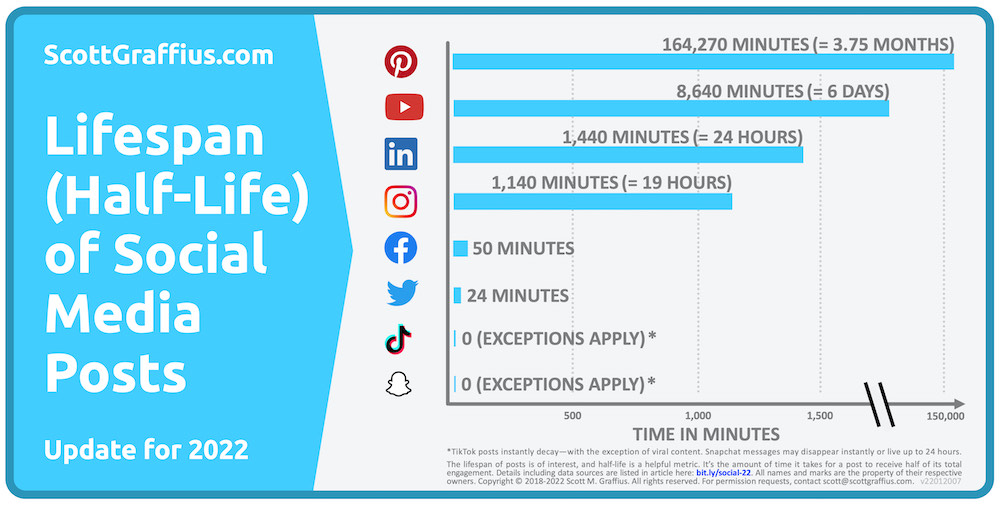

If there are any supplements or updates to this article after the date of publication, they will appear in the Post-Publication Notes section at the end of this article.

2022 Update
Social media marketing is one of the most important aspects of digital marketing. It involves creating and sharing content on social media networks in order to advance business objectives such as marketing and branding goals. When well-executed, it delivers several benefits: improved brand and marketplace awareness, engagement with a worldwide audience, increased traffic, enhanced search engine optimization (SEO) rankings, and more.
The lifespan of posts is of interest, and a helpful metric is half-life. It’s the amount of time it takes for a post to receive half of its total engagement (such as likes, shares, and comments). The data can help inform the scheduling of posts.
This article reveals the lifespan (half-life) for posts on Twitter, Facebook, Instagram, LinkedIn, YouTube, Pinterest, TikTok, and Snapchat. Findings are based on an analysis of data from 21 sources: Adobe, Bit.ly, Business Insider, Espirian, Exceptional PPM and PMO Solutions, Fanbooster (Traject), Google, Klout, Later, Moz, New York Times, Pinterest, Simply Measured, Snapchat, Social Media University—Global, TechniqueHow, The Online Advertising Guide, TikTok, University of Akron, WebFX, and Wiselytics. In cases where data sources for a platform reported different values, the average was applied. As detailed next, the half-life of posts varies by platform.
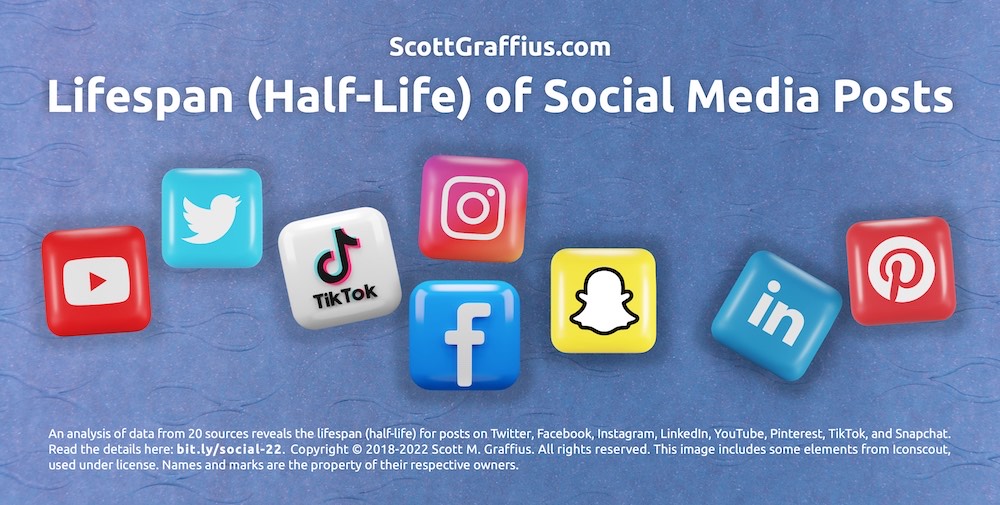
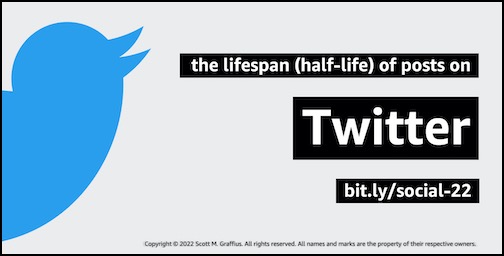
The average half-life duration for tweets is 24 minutes. That's longer than the 21 minutes shown in the earlier analysis which was conducted in 2021.
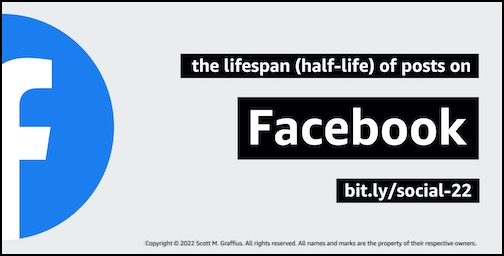
The average half-life duration for Facebook posts is 50 minutes. That's longer than the 30 minutes shown in the earlier analysis which was conducted in 2021.
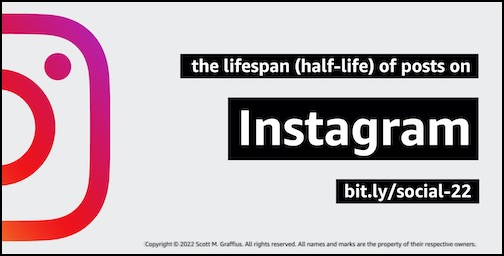
The average half-life duration for Instagram posts is 1,140 minutes (= 19 hours). That's unchanged from what was shown in the earlier analysis which was conducted in 2021.
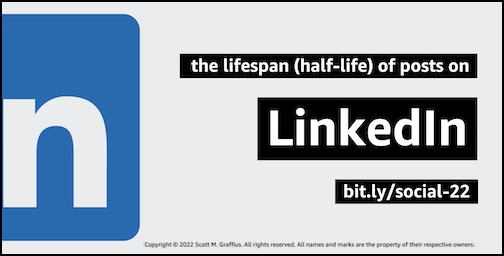
The average half-life duration for LinkedIn posts is 1,440 minutes (= 24 hours). That's unchanged from what was shown in the earlier analysis which was conducted in 2021.
YouTube
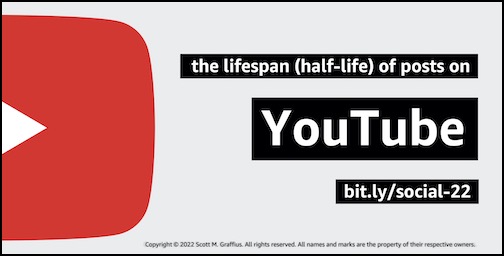
The average half-life duration for YouTube posts is 8,640 minutes (= 6 days). That's unchanged from what was shown in the earlier analysis which was conducted in 2021.
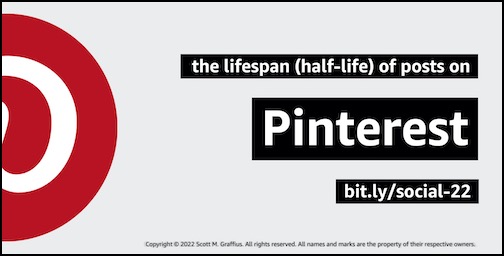
The average half-life duration for Pinterest posts is 164,270 minutes (= 3.75 months). That's longer than the 3.50 months shown in the earlier analysis which was conducted in 2021.
TikTok
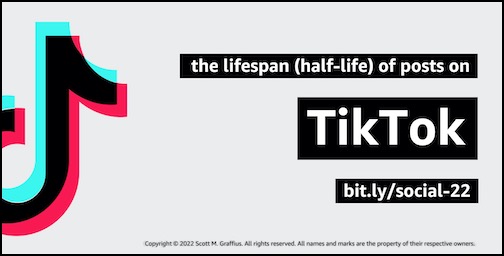
The average half-life duration for TikTok posts is 0 minutes. Exceptions apply: TikTok posts instantly decay—except for viral content. That's unchanged from what was shown in the earlier analysis which was conducted in 2021.
Snapchat
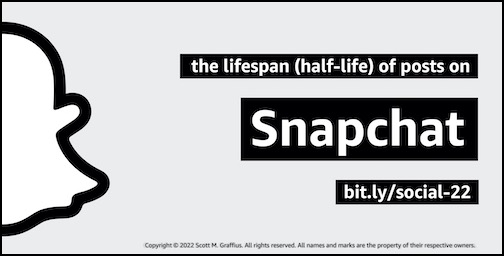
The average half-life duration for Snapchat posts is 0 minutes. Exceptions apply: Snapchat messages may disappear instantly or live up to 24 hours. That's unchanged from what was shown in the earlier analysis which was conducted in 2021.

As shown, half-life values vary by platform. The data can help inform the scheduling of posts.

Permission Requests and Downloadable High-Resolution Versions of 'Lifespan (Half-Life) of Social Media Posts: Update for 2022' Infographic-Visual
To request permission to use the 'Lifespan (Half-Life) of Social Media Posts' visual shown at the top of this article, contact Scott M. Graffius.
High resolution versions of the image appearing at the top of this article are available at the following links: here for the JPG file and here for the PNG file.
How to cite: Graffius, Scott M. (2022). Lifespan (Half-Life) of Social Media Posts. Version 2022. Available at ScottGraffius.com.

About Scott M. Graffius

Scott M. Graffius, PMP, CSP-SM, CSP-PO, CSM, CSPO, SFE, ITIL, LSSGB is an agile project management practitioner, consultant, multi award-winning author, and international speaker. He has generated over $1.75 billion of business value in aggregate for the organizations he has served. Graffius is the founder, CEO, and principal consultant at Exceptional PPM and PMO Solutions™ and subsidiary Exceptional Agility™. His expertise spans project, program, portfolio, and PMO leadership inclusive of agile, traditional, and hybrid approaches. Content from his books, workshops, speaking engagements, and more have been featured and used by businesses, professional associations, governments, and universities including Microsoft, Oracle, Cisco, Gartner, Deloitte, Project Management Institute, IEEE, SANS Institute, U.S. Soccer Federation, English Institute of Sport, Ford, Qantas, Atlassian, Wrike, Bayer, National Academy of Sciences, United States Department of Energy, United States Army, New Zealand Ministry of Education, Amsterdam Public Health Research Institute, Tufts University, Texas A&M University, Warsaw University of Technology, University of Waterloo, National University of Ireland Galway, Zurich University of Applied Sciences, and others. Graffius has spoken at 59 conferences and other events around the world, including Armenia, Australia, Brazil, Canada, Czech Republic, Finland, France, Germany, Greece, Hungary, India, Ireland, Lithuania, Luxembourg, Netherlands, New Zealand, Sweden, United Arab Emirates, United Kingdom, and the United States. Thinkers360 named Graffius a global top thought leader and influencer in four domains: Agile, Change Management, Digital Transformation, and GovTech.
His full bio is available here.
Connect with Scott on:



Post-Publication Notes
Update on 6 January 2025
Algorithms and other factors on social media platforms change over time. For that reason, Scott M. Graffius periodically updates his 'Lifespan (Half-Life) of Social Media Posts' research. The most current edition is here.

The short URL for this article is: https://bit.ly/social-22

#Branding #ContentMarketing #Digital #DigitalContent #DigitalMarketing #DigitalMedia #DigitalStrategy #DigitalTactics #Facebook #Halflife #HalflifeForPosts #Instagram #InternetMarketing #LifespanOfSocialMediaPosts #LinkedIn #Marketing #Pinterest #Posts #SEO #ShelfLifeOfPosts #Snapchat #Social #SocialMarketing #SocialMedia #SocialMediaMarketing #SocialMediaPlatforms #TikTok #Twitter #YouTube

© Copyright 2022 Scott M. Graffius. All rights reserved. This material may not be published, broadcast, rewritten or redistributed without the express written permission of Scott M. Graffius.

Lifespan (Half-Life) of Social Media Posts: Update 2 for 2022
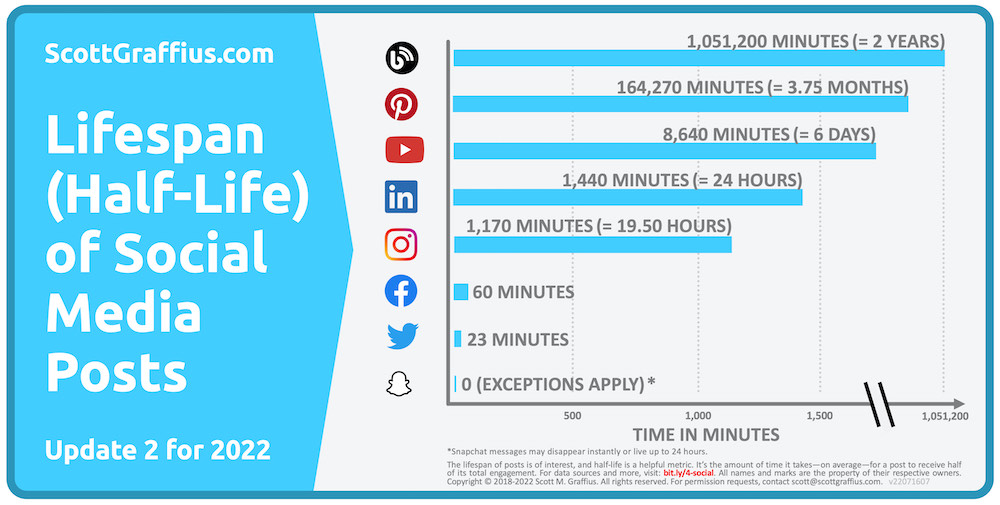
🔥 Scott M. Graffius periodically refreshes his research. The newest (2024) edition is here.
Click here to download this article as a PDF.
Update 2 for 2022
Social media marketing is one of the most important aspects of digital marketing. It involves creating and sharing content on social media networks in order to advance business objectives such as marketing and branding goals. When well-executed, it delivers multiple benefits: improved brand and marketplace awareness, engagement with a worldwide audience, increased traffic, enhanced search engine optimization (SEO) rankings, and more.
When content is published online, relevance and engagement have a limited lifespan. The duration is of interest, and a helpful objective metric is half-life. It’s the amount of time it takes for a post to receive half of its total engagement (such as likes, shares, and comments). The data can help inform strategic and tactical decisions, such as the frequency/scheduling of posts.
Based on an analysis of data from 25 diverse sources, this article reveals the average lifespan (half-life) for posts on Twitter, Facebook, Instagram, LinkedIn, YouTube, Pinterest, Snapchat, and blogs. Here are the sources: Adobe, Bit.ly, Business Insider, Emeritus, Espirian, Exceptional PPM and PMO Solutions, Fanbooster (Traject), Forbes, Google, Ignite Social Media, Klout, Later, Moz, New York Times, Pinterest, Science.org, Sculpt - B2B Social Media Agency, Simply Measured, Snapchat, Social Media University—Global, TechniqueHow, The Online Advertising Guide, University of Akron, WebFX, and Wiselytics. In cases where data sources for a platform reported different values, the average was applied. As detailed next, the half-life of posts varies by platform.
- Twitter: The average half-life duration for tweets is 23 minutes. That's 1 minute shorter than the 24 minutes shown in the earlier analysis which was conducted in January 2022.
- Facebook: The average half-life duration for Facebook posts is 60 minutes. That's 10 minutes longer than the 50 minutes shown in the earlier analysis which was conducted in January 2022.
- Instagram: The average half-life duration for Instagram posts is 1,170 minutes (= 19.50 hours). That's 30 minutes longer than the 1,140 minutes shown in the earlier analysis which was conducted in January 2022.
- LinkedIn: The average half-life duration for LinkedIn posts is 1,440 minutes (= 24 hours). That's unchanged from what was shown in the earlier analysis which was conducted in January 2022.
- YouTube: The average half-life duration for YouTube posts is 8,640 minutes (= 6 days). That's unchanged from what was shown in the earlier analysis which was conducted in January 2022.
- Pinterest: The average half-life duration for Pinterest posts is 164,270 minutes (= 3.75 months). That's unchanged from what was shown in the earlier analysis which was conducted in January 2022.
- Snapchat: The average half-life duration for Snapchat posts is 0 minutes. Exceptions apply: Snapchat messages may disappear instantly or live up to 24 hours. That's unchanged from what was shown in the earlier analysis which was conducted in January 2022.
- Blogs: The average half-life duration for blog posts is 1,051,200 minutes (= 2 years). This is the first time blogs are included in the analysis.

As shown, half-life values vary by platform. The data can help inform the scheduling of posts.

Permission Requests and Downloadable High-Resolution Versions of 'Lifespan (Half-Life) of Social Media Posts: Update 2 for 2022' Infographic-Visual
To request permission to use the 'Lifespan (Half-Life) of Social Media Posts' visual shown at the top of this article, contact Scott M. Graffius.
High resolution versions of the image appearing at the top of this article are available at the following links: JPG file and PNG file.
How to cite: Graffius, Scott M. (2022, July). Lifespan (Half-Life) of Social Media Posts. Update 2 for 2022. Available at ScottGraffius.com.

About Scott M. Graffius

Scott M. Graffius, PMP, CSP-SM, CSP-PO, CSM, CSPO, SFE, ITIL, LSSGB is an agile project management practitioner, consultant, multi award-winning author, and international speaker. He has generated over $1.75 billion of business value in aggregate for the organizations he has served. Graffius is the founder, CEO, and principal consultant at Exceptional PPM and PMO Solutions™ and subsidiary Exceptional Agility™. Content from his books (Agile Scrum: Your Quick Start Guide with Step-by-Step Instructions and Agile Transformation: A Brief Story of How an Entertainment Company Developed New Capabilities and Unlocked Business Agility to Thrive in an Era of Rapid Change), workshops, speaking engagements, and more have been featured and used by businesses, professional associations, governments, and universities including Microsoft, Oracle, Broadcom, Cisco, Gartner, Deloitte, EY, Project Management Institute, IEEE, SANS Institute, U.S. Soccer Federation, English Institute of Sport, Ford, Qantas, Atlassian, Wrike, Bayer, National Academy of Sciences, United States Department of Energy, United States Army, United States National Park Service, New Zealand Ministry of Education, Amsterdam Public Health Research Institute, Tufts University, Texas A&M University, Warsaw University of Technology, University of Waterloo, National University of Ireland Galway, Zurich University of Applied Sciences, and others. Graffius delivers dynamic and engaging talks and workshops at public and private/corporate events. His engagements total 78 in-person and online conferences and other events around the world, including Armenia, Australia, Brazil, Canada, Czech Republic, Finland, France, Germany, Greece, Hungary, India, Ireland, Lithuania, Luxembourg, Nepal, Netherlands, New Zealand, Sweden, Switzerland, United Arab Emirates, United Kingdom, and the United States. Graffius delights audiences with sessions on technology leadership and project, program, portfolio, and PMO management inclusive of agile, waterfall, and hybrid approaches. He uses everyday language and vibrant custom visuals to make complex topics clear, and he provides audiences with practical information they can use.
His full bio is available here.
Connect with Scott on:


The short URL for this article is: https://bit.ly/4-social
#Branding #Blogs #ContentMarketing #Digital #DigitalContent #DigitalMarketing #DigitalMedia #DigitalStrategy #DigitalTactics #Facebook #Halflife #HalflifeForPosts #Instagram #InternetMarketing #LifespanOfSocialMediaPosts #LinkedIn #Marketing #Pinterest #Posts #SEO #ShelfLifeOfPosts #Snapchat #Social #SocialMarketing #SocialMedia #SocialMediaMarketing #SocialMediaPlatforms #TikTok #Twitter #YouTube
© Copyright 2022 Scott M. Graffius. All rights reserved. This material may not be published, broadcast, rewritten or redistributed without the express written permission of Scott M. Graffius.

Lifespan (Half-Life) of Social Media Posts: Update for 2023
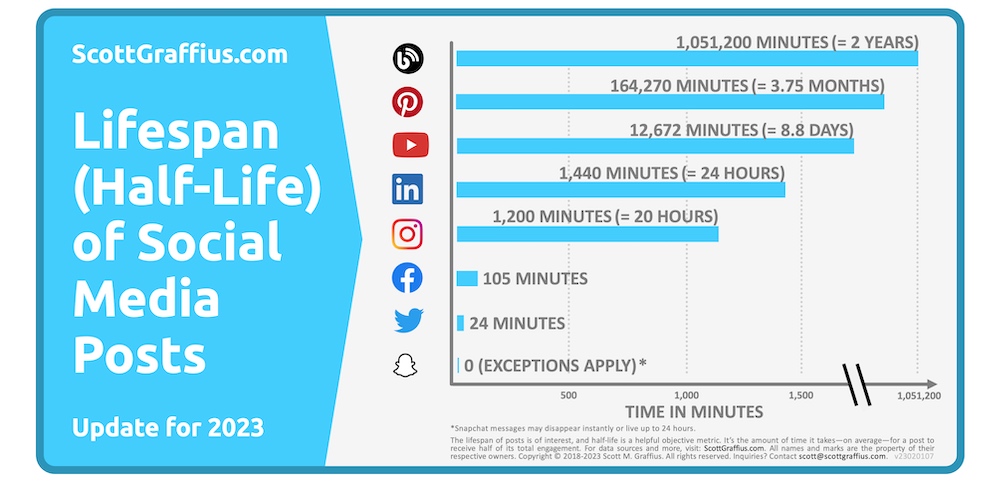

If there are any supplements or updates to this article after the date of publication, they will appear in the Post-Publication Notes section at the end of this article.

Update for 2023
In 2018, Scott M. Graffius first published data on the lifespan (half-life) of social media posts. As algorithms and other factors on platforms change over time¹, Graffius periodically updates the analysis. This is the update for 2023.
Digital marketing involves utilizing tools, processes, content, and techniques to advance goals such as traffic, visibility, and sales for individuals, brands, and businesses. An increasingly important form of digital marketing is social media marketing. It involves creating and sharing content on social media networks. When well-executed, it delivers multiple benefits, including:
- Improved brand and marketplace awareness,
- Engagement with a global audience — there are 4,700,000,000 (4.7 billion) active social media users worldwide²,
- Increased traffic,
- Enhanced search engine optimization (SEO) rankings,
- And more.
When content is published online, relevance and engagement have a limited lifespan. An advantageous objective metric is half-life. It’s the amount of time it takes for a post to receive half of its total engagement (such as likes, shares, and comments). The data can help inform strategic and tactical decisions, such as the frequency/scheduling of posts.
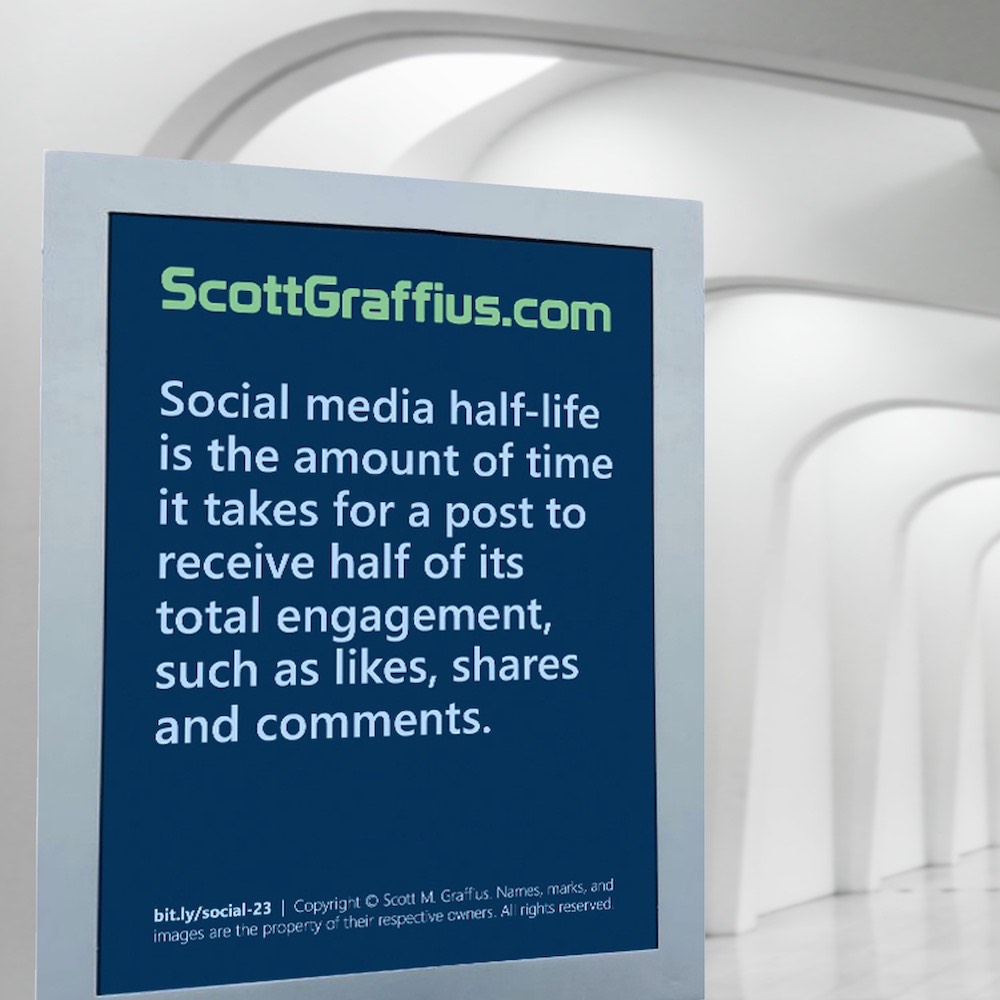
Based on an analysis of data from 32 diverse sources listed below³, this article reveals the average lifespan (half-life) for posts on Twitter, Facebook, Instagram, LinkedIn, YouTube, Pinterest, Snapchat, and blogs. In cases where data sources reported different values for a platform, the average was applied.
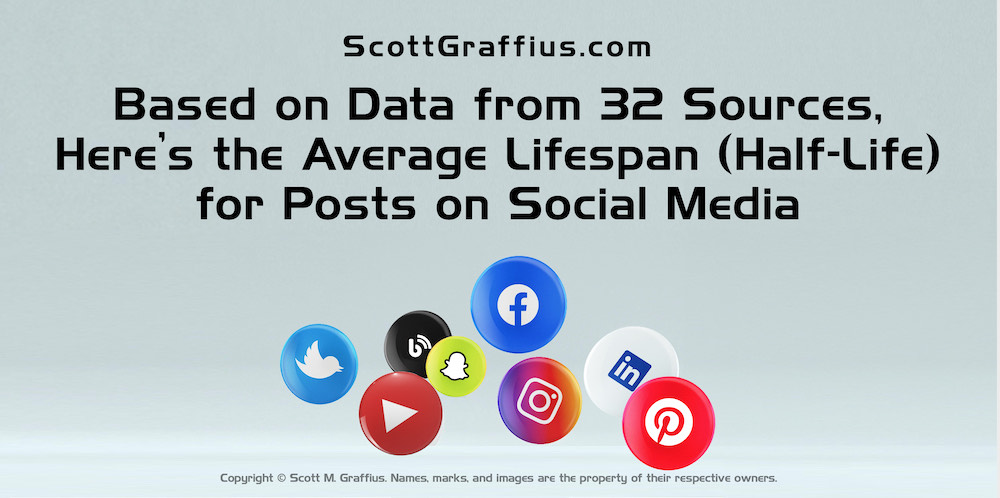
As detailed next, the half-life of posts varies by platform.
⋯⋯⋯

Snapchat is a multimedia instant messaging app and service developed by Snap Inc. A distinguishing feature of the platform is that pictures and messages are usually only available for a short time before they become inaccessible to their recipients. Snapchat has 557,000,000 (557 million) active users.⁴
The average half-life duration for Snapchat posts is 0 minutes.³ Exceptions apply: Snapchat messages may disappear instantly or live up to 24 hours. That's unchanged from what was shown in the prior analysis which was conducted and published at ScottGraffius.com in July 2022.
⋯⋯⋯

Twitter is a microblogging and social networking service owned by X Holdings II, Inc. (a wholly owned subsidiary of X Holdings I, Inc., wholly owned by Elon Musk), on which users post and interact with messages known as "tweets". Twitter has 436,000,000 (436 million) active users.⁴
The average half-life duration for tweets is 24 minutes.³ That's 1 minute longer than the 23 minutes shown in the prior analysis which was conducted and published at ScottGraffius.com in July 2022.
⋯⋯⋯

Facebook is an online social media and social networking service owned by Meta Platforms. It's the third most visited website. Facebook has 2,910,000,000 (2.91 billion) active users.⁴
The average half-life duration for Facebook posts is 105 minutes (= 1.75 hours).³ That's 45 minutes longer than the 60 minutes shown in the prior analysis which was conducted and published at ScottGraffius.com in July 2022.
⋯⋯⋯

Instagram is a photo and video sharing service owned by Meta Platforms. The app allows users to upload media that can be edited with filters and organized by hashtags and geographical tagging. Users can browse other users' content by tag and location, view trending content, like photos, and follow other users to add their content to a personal feed. Instagram has 1,478,000,000 (1.478 billion) active users.⁴
The average half-life duration for Instagram posts is 1,200 minutes (= 20 hours).³ That's 30 minutes longer than the 1,170 minutes shown in the prior analysis which was conducted and published at ScottGraffius.com in July 2022.
⋯⋯⋯

LinkedIn is a business and employment-oriented online service. It's a wholly owned subsidiary of Microsoft. LinkedIn claims to have 830,000,000+ (830 million) users.⁵ However, it does not report how many of those users are active users. Active users may be significantly less than the total number of users.
The average half-life duration for LinkedIn posts is 1,440 minutes (= 24 hours).³ That's unchanged from what was shown in the prior analysis which was conducted and published at ScottGraffius.com in July 2022.
⋯⋯⋯

YouTube is an online video sharing and social media platform. It's owned by Google, and it's the second most visited website, after Google Search. YouTube has 2,562,000,000 (2.562 billion) active users.⁴
The average half-life duration for YouTube posts is 12,672 minutes (= 8.8 days).³ That's 4,032 minutes longer than the 8,640 minutes shown in the prior analysis which was conducted and published at ScottGraffius.com in July 2022.
⋯⋯⋯

Pinterest is an image sharing and social media service designed to enable saving and discovery of information (specifically "ideas") on the internet using images — and on a smaller scale, animated GIFs and videos — in the form of pinboards. The service is operated by Pinterest, Inc. It has 444,000,000 (444 million) active users.⁴
The average half-life duration for Pinterest posts is 164,270 minutes (= 3.75 months).³ That's unchanged from what was shown in the prior analysis which was conducted and published at ScottGraffius.com in July 2022.
⋯⋯⋯

Blogs (a truncation of "weblogs") are discussion or informational websites consisting of discrete, often diary-style entries. Up until 2009, blogs were usually the work of an individual and each typically covered a single subject or topic. In the 2010s, multi-author blogs (MABs) from media outlets and others emerged. In addition to featuring the writings of multiple authors, MABs often span a range of topics. It is estimated that there are over 572,000,000 (572 million) blogs.⁶
The average half-life duration for blog posts is 1,051,200 minutes (= 2 years).³ That's unchanged from what was shown in the prior analysis which was conducted and published at ScottGraffius.com in July 2022.

As shown, half-life values vary by platform. The data can help inform strategic and tactical decisions, such as the frequency/scheduling of posts.


References / Sources:
- Forbes's report, "A Guide to Social Media Algorithms and SEO."
- Statista's report, "Social Media - Statistics and Facts."
- We analyzed data from 32 diverse sources, including: Adobe, Bit.ly, Business Insider, Business Standard, Emeritus, Espirian, Exceptional PPM and PMO Solutions, Fanbooster (Traject), Fast Company, Forbes, Google, IEEE, Ignite Social Media, Klout, Later, Moz, New York Times, Pinterest, Royal Town Planning Institute, Science.org, Sculpt - B2B Social Media Agency, Simply Measured, Snapchat, Social Media Marketing, Social Media University—Global, TechniqueHow, The Online Advertising Guide, Université de Genève (University of Geneva), University of Akron, Washington Post, WebFX, and Wiselytics.
- Statista’s report, "Most Popular Social Networks Worldwide."
- LinkedIn.
- First Site Guide’s report, "Blogging Statistics 2022."


How to cite this article:
Graffius, Scott M. (2023, January 1). The Lifespan (Half-Life) of Social Media Posts: Update for 2023. Available at https://www.ScottGraffius.com.


To request permission to use the 'Lifespan (Half-Life) of Social Media Posts' visual shown at the top of this article (or any other content in this article), contact Scott M. Graffius. If approved, high resolution JPG and PNG versions of the image, if applicable, will be provided along with terms and conditions.



About Scott M. Graffius

Scott M. Graffius, PMP, CSP-SM, CSP-PO, CSM, CSPO, SFE, ITIL, LSSGB is an agile project management practitioner, consultant, multi award-winning author, and highly sought-after international keynote speaker. He has generated over $1.75 billion of business value in aggregate for the organizations he has served. Graffius is the CEO and Principal Consultant at Exceptional PPM and PMO Solutions™ and subsidiary Exceptional Agility™. Content from his books, talks, workshops, and more have been featured and used by businesses, professional associations, governments, and universities. Select examples include Microsoft, Oracle, Broadcom, Cisco, Gartner, Project Management Institute, IEEE, U.S. Soccer Federation, Qantas, National Academy of Sciences, U.S. Department of Energy, U.S. National Park Service, New Zealand Ministry of Education, Yale University, Warsaw University of Technology, and others. Graffius has delighted audiences with dynamic and engaging talks and workshops on agile, project management, and technology leadership at 82 conferences and other events across 24 countries.
His full bio is available here.
Connect with Scott on:
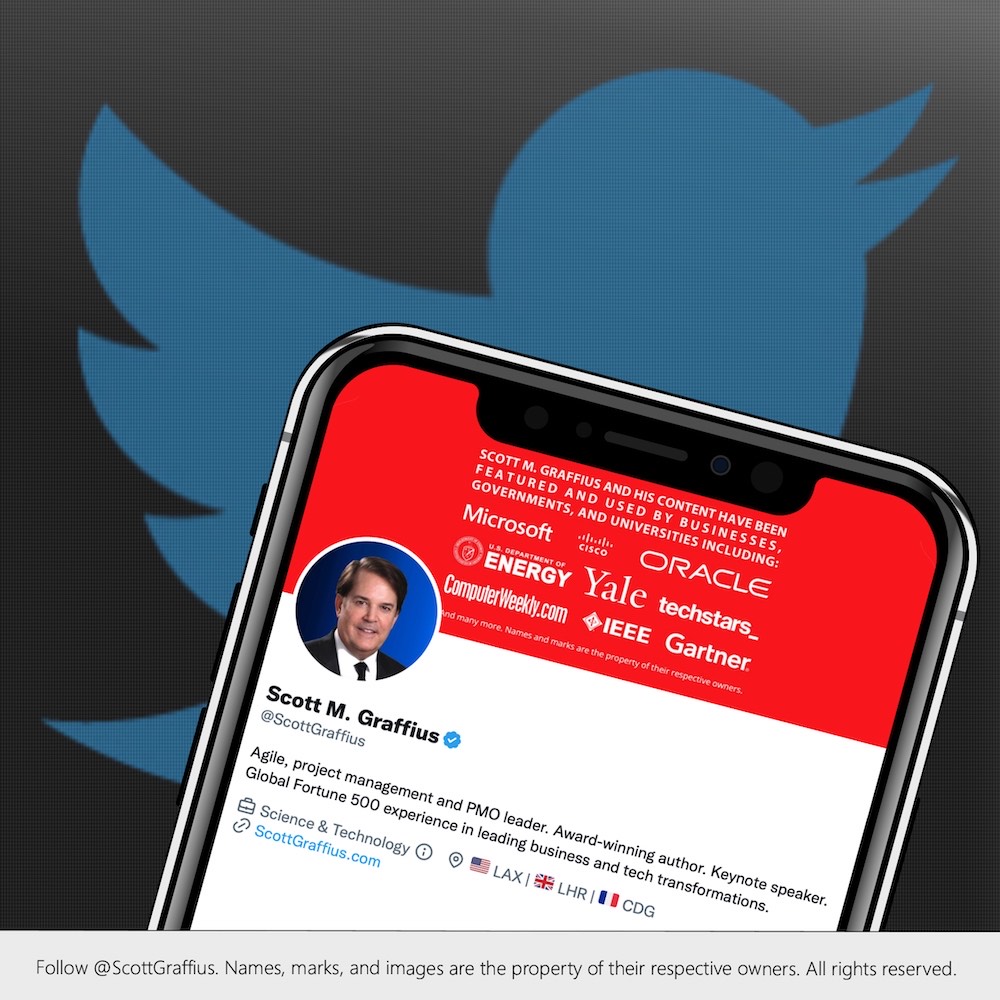

About Agile Scrum: Your Quick Start Guide with Step-by-Step Instructions

Shifting customer needs are common in today's marketplace. Businesses must be adaptive and responsive to change while delivering an exceptional customer experience to be competitive.
There are a variety of frameworks supporting the development of products and services, and most approaches fall into one of two broad categories: traditional or agile. Traditional practices such as waterfall engage sequential development, while agile involves iterative and incremental deliverables. Organizations are increasingly embracing agile to manage projects, and best meet their business needs of rapid response to change, fast delivery speed, and more.
With clear and easy to follow step-by-step instructions, Scott M. Graffius's award-winning Agile Scrum: Your Quick Start Guide with Step-by-Step Instructions helps the reader:
- Implement and use the most popular agile framework―Scrum;
- Deliver products in short cycles with rapid adaptation to change, fast time-to-market, and continuous improvement; and
- Support innovation and drive competitive advantage.
Hailed by Literary Titan as “the book highlights the versatility of Scrum beautifully.”
Winner of 17 first place awards.
Agile Scrum: Your Quick Start Guide with Step-by-Step Instructions is available in paperback and ebook/Kindle in the United States and around the world. Some links by country follow.
- 🇧🇷 Brazil
- 🇨🇦 Canada
- 🇨🇿 Czech Republic
- 🇩🇰 Denmark
- 🇫🇮 Finland
- 🇫🇷 France
- 🇩🇪 Germany
- 🇬🇷 Greece
- 🇭🇺 Hungary
- 🇮🇳 India
- 🇮🇪 Ireland
- 🇮🇱 Israel
- 🇮🇹 Italy
- 🇯🇵 Japan
- 🇱🇺 Luxembourg
- 🇲🇽 Mexico
- 🇳🇱 Netherlands
- 🇳🇿 New Zealand
- 🇳🇴 Norway
- 🇪🇸 Spain
- 🇸🇪 Sweden
- 🇨🇭 Switzerland
- 🇦🇪 UAE
- 🇬🇧 United Kingdom
- 🇺🇸 United States

About Agile Transformation: A Brief Story of How an Entertainment Company Developed New Capabilities and Unlocked Business Agility to Thrive in an Era of Rapid Change

Thriving in today's marketplace frequently depends on making a transformation to become more agile. Those successful in the transition enjoy faster delivery speed and ROI, higher satisfaction, continuous improvement, and additional benefits.
Based on actual events, Agile Transformation: A Brief Story of How an Entertainment Company Developed New Capabilities and Unlocked Business Agility to Thrive in an Era of Rapid Change provides a quick (60-90 minute) read about a successful agile transformation at a multinational entertainment and media company, told from the author's perspective as an agile coach.
The award-winning book by Scott M. Graffius is available in paperback and ebook/Kindle in the United States and around the world. Some links by country follow.
- 🇦🇺 Australia
- 🇦🇹 Austria
- 🇧🇷 Brazil
- 🇨🇦 Canada
- 🇨🇿 Czech Republic
- 🇩🇰 Denmark
- 🇫🇮 Finland
- 🇫🇷 France
- 🇩🇪 Germany
- 🇬🇷 Greece
- 🇮🇳 India
- 🇮🇪 Ireland
- 🇯🇵 Japan
- 🇱🇺 Luxembourg
- 🇲🇽 Mexico
- 🇳🇱 Netherlands
- 🇳🇿 New Zealand
- 🇪🇸 Spain
- 🇸🇪 Sweden
- 🇨🇭 Switzerland
- 🇦🇪 United Arab Emirates
- 🇬🇧 United Kingdom
- 🇺🇸 United States


Post-Publication Notes
Update on 6 January 2025
Algorithms and other factors on social media platforms change over time. For that reason, Scott M. Graffius periodically updates his 'Lifespan (Half-Life) of Social Media Posts' research. The most current edition is here.

© Copyright 2023 Scott M. Graffius. All rights reserved. This material may not be published, broadcast, rewritten or redistributed without the express written permission of Scott M. Graffius.

Research by Scott M. Graffius Referenced in the 'Proceedings of the National Academy of Sciences of the United States of America'
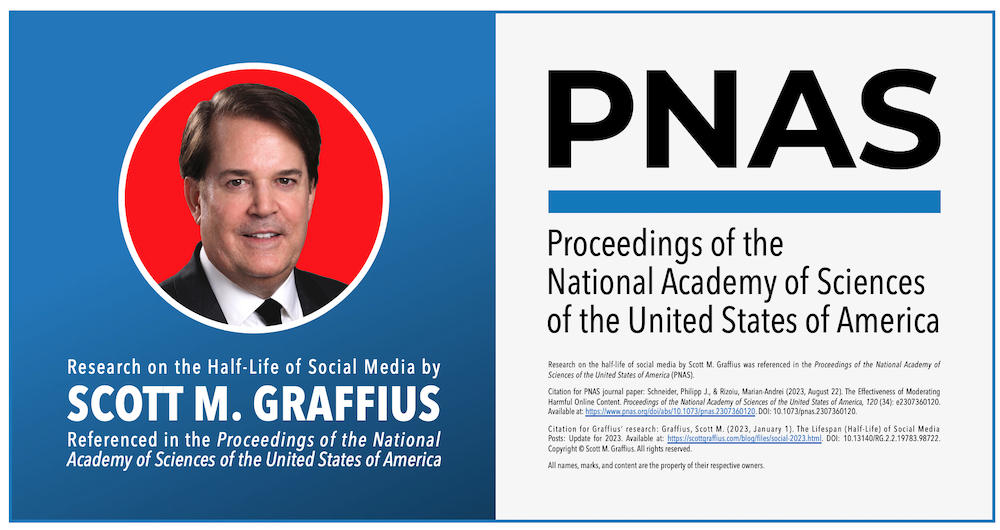
Select here to download a PDF of this article.
The Proceedings of the National Academy of Sciences of the United States of America (PNAS) references Scott M. Graffius' research on the half-life of social media. Highlights follow.
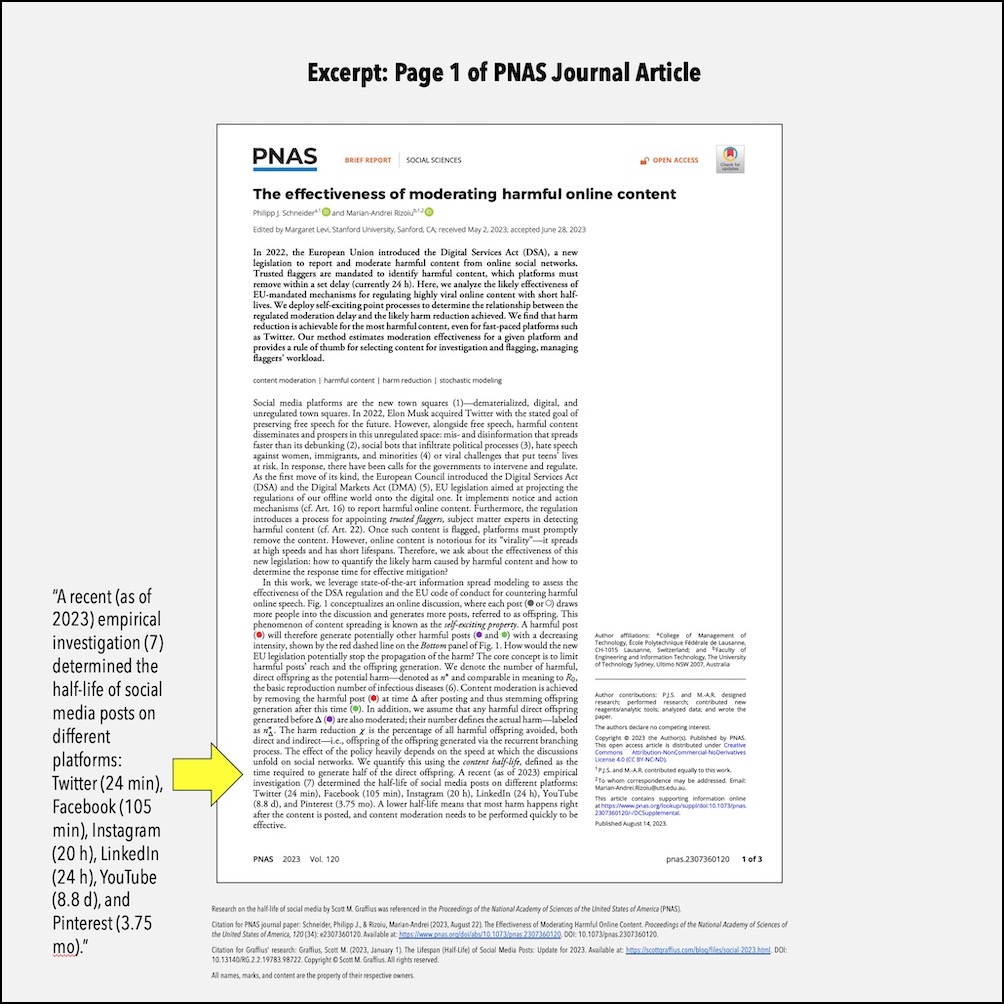
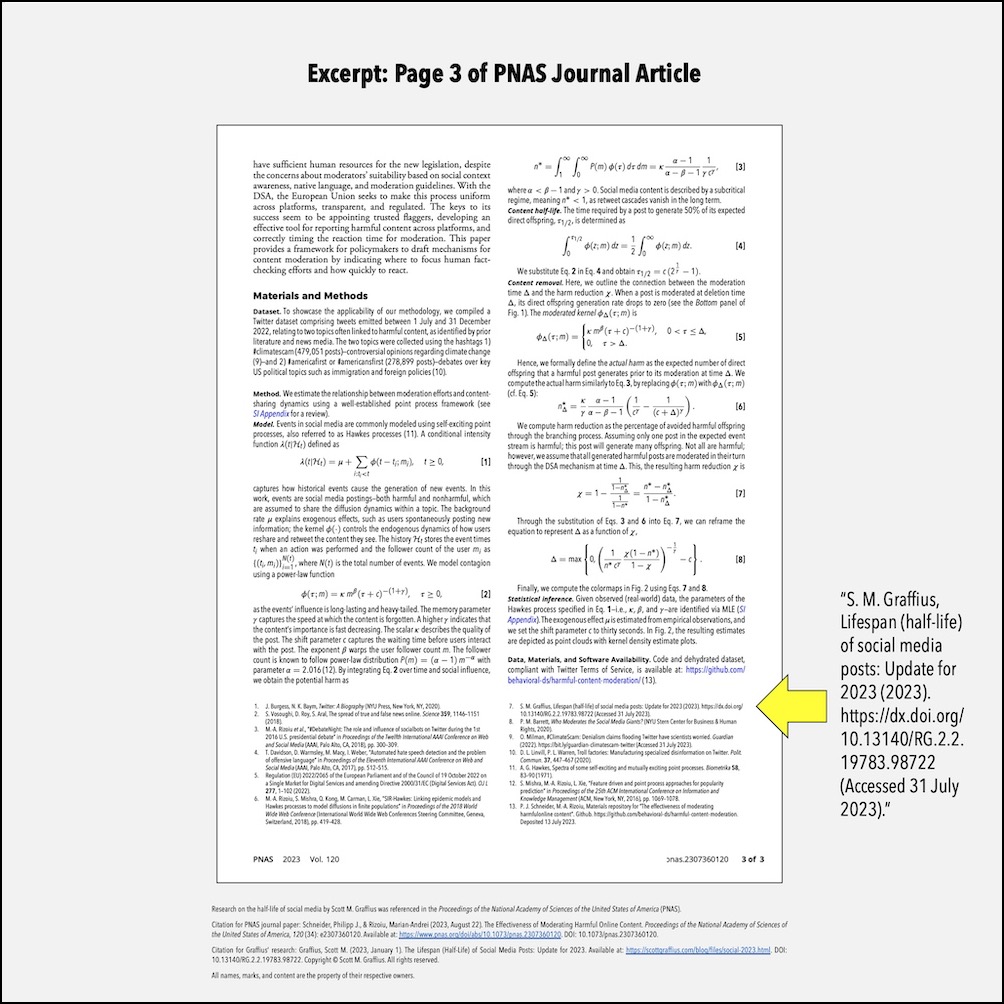
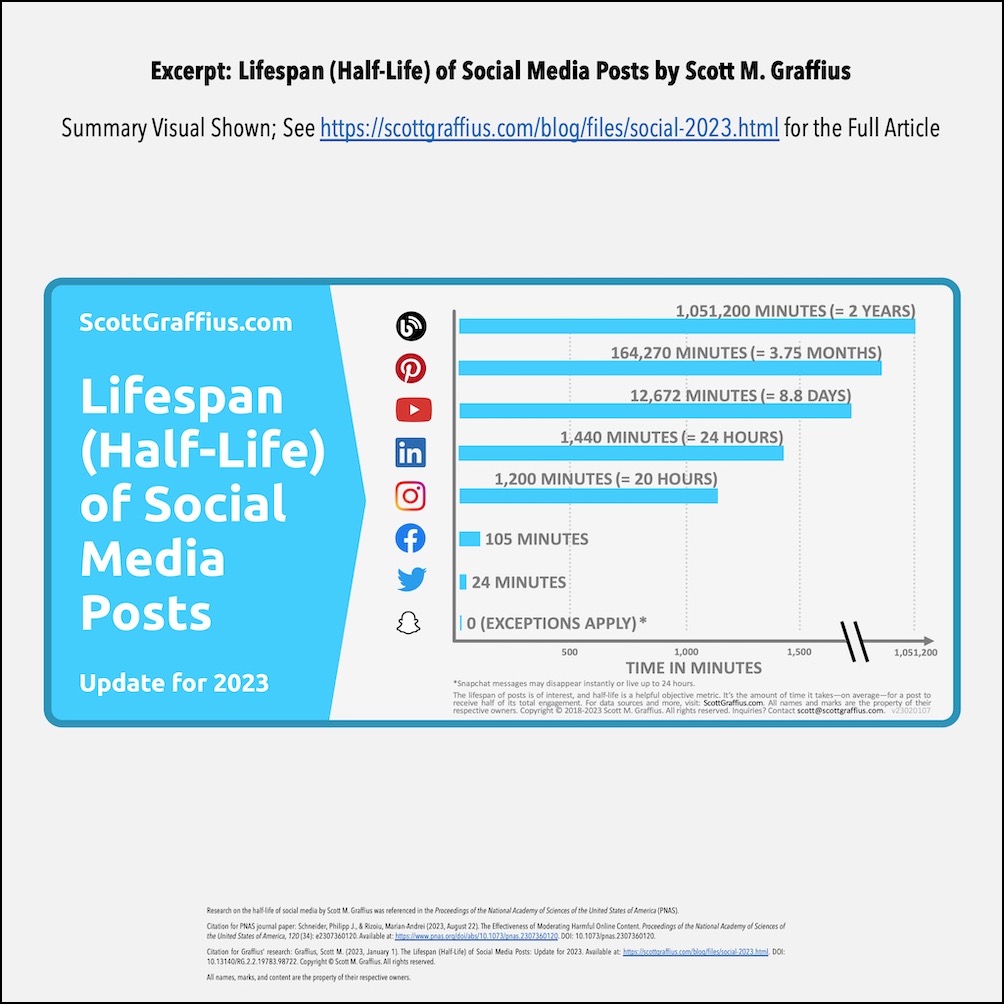
Thanks to the authors of the PNAS journal article:
- Philipp J. Schneider - College of Management of Technology, École Polytechnique Fédérale de Lausanne (EPFL), CH-1015 Lausanne, Switzerland; and
- Marian-Andrei Rizoiu - Faculty of Engineering and Information Technology, The University of Technology Sydney (UTS), Ultimo NSW 2007, Australia.
Citation for PNAS journal article:
Schneider, Philipp J., & Rizoiu, Marian-Andrei (2023, August 22). The Effectiveness of Moderating Harmful Online Content. Proceedings of the National Academy of Sciences of the United States of America, 120 (34): e2307360120. Available at: https://www.pnas.org/doi/abs/10.1073/pnas.2307360120. DOI: 10.1073/pnas.2307360120.
Citation for Graffius’ research:
Graffius, Scott M. (2023, January 1). The Lifespan (Half-Life) of Social Media Posts: Update for 2023. Available at: https://scottgraffius.com/blog/files/social-2023.html. DOI: 10.13140/RG.2.2.19783.98722. Copyright © Scott M. Graffius. All rights reserved.
About the PNAS
The Proceedings of the National Academy of Sciences of the United States of America (PNAS), a peer reviewed journal of the National Academy of Sciences (NAS), is an authoritative source of high-impact, original research that broadly spans the biological, physical, and social sciences. The journal is global in scope and submission is open to researchers worldwide.



About Scott M. Graffius

Scott M. Graffius, PMP, SA, CSP-SM, CSP-PO, CSM, CSPO, SFE, ITIL, LSSGB is an agile project management practitioner, consultant, multi-award-winning author, and international keynote speaker. He is the Founder of Exceptional PPM and PMO Solutions™ and subsidiary Exceptional Agility™. He has generated over $1.9 billion of business value in aggregate for Global Fortune 500 businesses and other organizations he has served. Graffius and content from his books, talks, workshops, and more have been featured and used by businesses, professional associations, governments, and universities. Examples include Microsoft, Oracle, Broadcom, Cisco, Gartner, Project Management Institute, IEEE, Qantas, National Academy of Sciences, United States Department of Energy, New Zealand Ministry of Education, Yale University, Tufts University, and others. He has delighted audiences with dynamic and engaging talks and workshops on agile, project management, and technology (including AI) leadership at 87 conferences and other events across 25 countries.
His full bio is available here.
Connect with Scott on:


About Agile Scrum: Your Quick Start Guide with Step-by-Step Instructions

Shifting customer needs are common in today's marketplace. Businesses must be adaptive and responsive to change while delivering an exceptional customer experience to be competitive.
There are a variety of frameworks supporting the development of products and services, and most approaches fall into one of two broad categories: traditional or agile. Traditional practices such as waterfall engage sequential development, while agile involves iterative and incremental deliverables. Organizations are increasingly embracing agile to manage projects, and best meet their business needs of rapid response to change, fast delivery speed, and more.
With clear and easy to follow instructions, the multi award-winning Agile Scrum: Your Quick Start Guide with Step-by-Step Instructions book by Scott M. Graffius (Chris Hare and Colin Giffen, Technical Editors) helps the reader:
- Implement and use the most popular agile framework―Scrum;
- Deliver products in short cycles with rapid adaptation to change, fast time-to-market, and continuous improvement; and
- Support innovation and drive competitive advantage.
Hailed by Literary Titan as “the book highlights the versatility of Scrum beautifully.”
Winner of 17 first place awards.
Agile Scrum: Your Quick Start Guide with Step-by-Step Instructions is available in paperback and ebook/Kindle in the United States and around the world. Some links by country follow.
- 🇧🇷 Brazil
- 🇨🇦 Canada
- 🇨🇿 Czech Republic
- 🇩🇰 Denmark
- 🇫🇮 Finland
- 🇫🇷 France
- 🇩🇪 Germany
- 🇬🇷 Greece
- 🇭🇺 Hungary
- 🇮🇳 India
- 🇮🇪 Ireland
- 🇮🇱 Israel
- 🇮🇹 Italy
- 🇯🇵 Japan
- 🇱🇺 Luxembourg
- 🇲🇽 Mexico
- 🇳🇱 Netherlands
- 🇳🇿 New Zealand
- 🇳🇴 Norway
- 🇪🇸 Spain
- 🇸🇪 Sweden
- 🇨🇭 Switzerland
- 🇦🇪 UAE
- 🇬🇧 United Kingdom
- 🇺🇸 United States

About Agile Transformation: A Brief Story of How an Entertainment Company Developed New Capabilities and Unlocked Business Agility to Thrive in an Era of Rapid Change

Thriving in today's marketplace frequently depends on making a transformation to become more agile. Those successful in the transition enjoy faster delivery speed and ROI, higher satisfaction, continuous improvement, and additional benefits.
Based on actual events, Agile Transformation: A Brief Story of How an Entertainment Company Developed New Capabilities and Unlocked Business Agility to Thrive in an Era of Rapid Change provides a quick (60-90 minute) read about a successful agile transformation at a multinational entertainment and media company, told from the author's perspective as an agile coach.
The award-winning book by Scott M. Graffius is available in paperback and ebook/Kindle in the United States and around the world. Some links by country follow.
- 🇦🇺 Australia
- 🇦🇹 Austria
- 🇧🇷 Brazil
- 🇨🇦 Canada
- 🇨🇿 Czech Republic
- 🇩🇰 Denmark
- 🇫🇮 Finland
- 🇫🇷 France
- 🇩🇪 Germany
- 🇬🇷 Greece
- 🇮🇳 India
- 🇮🇪 Ireland
- 🇯🇵 Japan
- 🇱🇺 Luxembourg
- 🇲🇽 Mexico
- 🇳🇱 Netherlands
- 🇳🇿 New Zealand
- 🇪🇸 Spain
- 🇸🇪 Sweden
- 🇨🇭 Switzerland
- 🇦🇪 United Arab Emirates
- 🇬🇧 United Kingdom
- 🇺🇸 United States

The short URL for this article is: https://bit.ly/pnas-blog
© Copyright 2023 Scott M. Graffius. All rights reserved. This material may not be published, broadcast, rewritten or redistributed without the express written permission of Scott M. Graffius.

Lifespan (Half-Life) of Social Media Posts: Update for 2024
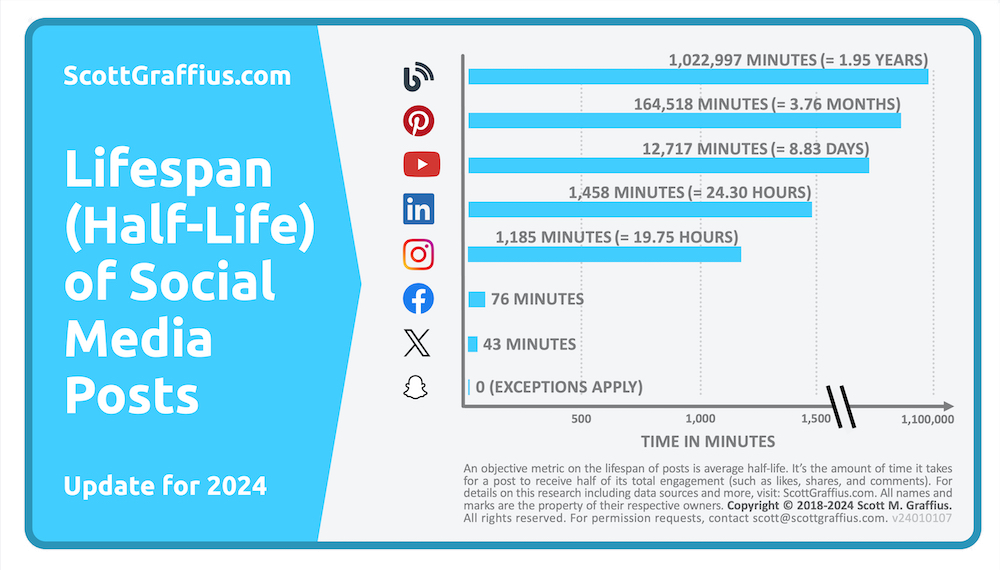

If there are any supplements or updates to this article after the date of publication, they will appear in the Post-Publication Notes section at the end of this article.


Introduction
Individuals and businesses use the Internet and other forms of digital communication to reach and engage target audiences and promote content. That’s digital marketing. It includes email, social media, web-based advertising, and text and multimedia messages.
A rapidly expanding component of digital marketing is social media marketing. It involves posting content on social media platforms such as Snapchat, X (formerly known as Twitter), Facebook, Instagram, LinkedIn, YouTube, Pinterest, and blogs. The platforms enable people to connect with family and friends, share information and ideas, and access news and entertainment. The platforms also play a vital role in business by providing companies with direct channels to reach and engage with their target audiences. When well-executed, social media marketing delivers multiple benefits, including:
- Engagement with a global audience — there are 4,950,000,000 (4.95 billion) active social media users worldwide.B1
- Improved brand and marketplace awareness and reach.
- Enhanced customer engagement.
- Increased website traffic.
- Improved search engine rankings.
- And more.
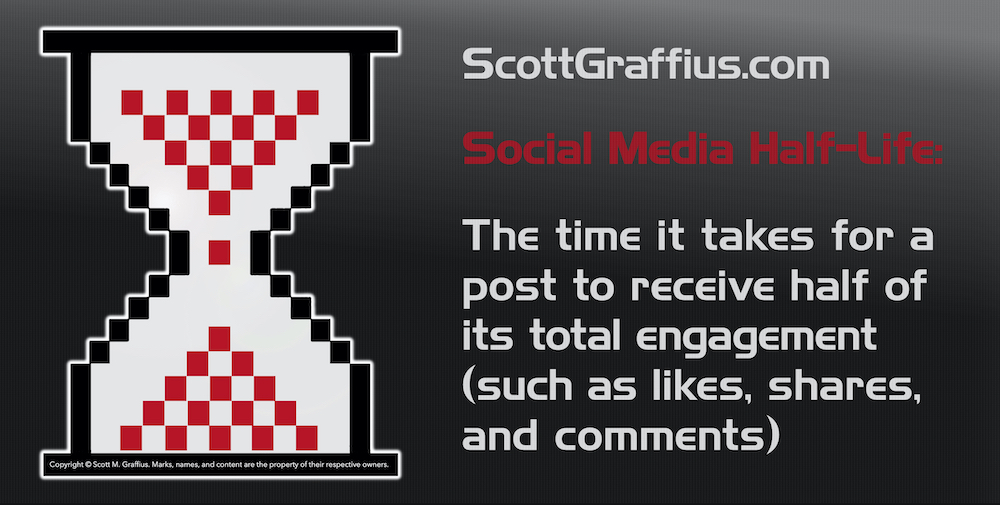
When content is published online, relevance and engagement have a limited lifespan. An advantageous objective metric is half-life. It’s the time it takes for a post to receive half of its total engagement (such as likes, shares, and comments). Data can help inform strategic and tactical decisions, such as the frequency and scheduling of posts.
In 2018, Scott M. Graffius first published data on the lifespan (half-life) of social media posts. Algorithms and other factors on platforms change over time.B2 For that reason, Graffius periodically updates the analysis. This article provides the update for 2024.
Reports by others on the shelf life of social media are often based on the experience of one person, one organization, or one limited set of data. With any of those common limitations, findings are at risk of being non-representative, inaccurate, or unreliable.
It’s important to have a broad set of data from multiple sources. In addition to generating results that are more likely to be appropriately representative, accurate, and reliable, this approach provides a more complete picture and helps identify trends. Graffius’ “Lifespan (Half-Life) of Social Media Posts: Update for 2024” — this research report — is built on data from 37 sources.A
Based on an analysis of data from 37 diverse sources,A this report reveals the average lifespan (half-life) for posts on Snapchat, X, Facebook, Instagram, LinkedIn, YouTube, Pinterest, and blogs.


Main Section of Article
As detailed next, the half-life of posts varies by social media platform.


Snapchat
Snapchat is a multimedia instant messaging app and service developed by Snap Inc., originally Snapchat Inc. A distinguishing feature of the platform is that pictures and messages are usually only available for a short time before they become inaccessible to their recipients. Snapchat has 750,000,000 (750 million) active users.B3
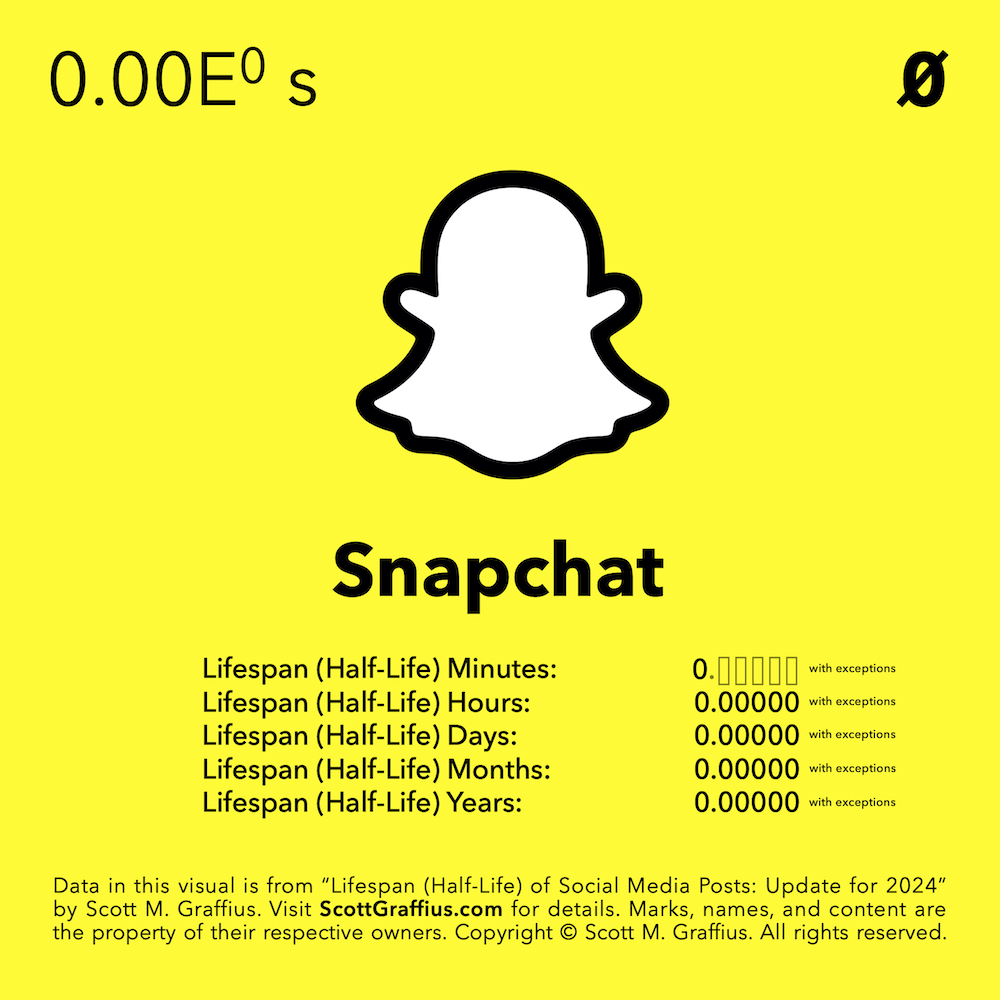
The average half-life duration for Snapchat posts is 0 minutes.A Exceptions apply. Snapchat messages may disappear instantly or live up to 24 hours (even longer in certain cases) depending on the type of message, user settings, and other details.
Algorithms and other factors on platforms can change over time, potentially impacting the average half-life duration for posts. For comparison, here’s data on Snapchat for 2024 along with the last two annual editions of this report:
- 2024: 0 minutes (exceptions apply).A
- 2023: 0 minutes (exceptions apply).B4
- 2022: 0 minutes (exceptions apply).B5


X
X (formerly known as Twitter) is a microblogging and social networking service owned by X Holdings II, Inc. (a wholly owned subsidiary of X Holdings I, Inc., wholly owned by Elon Musk), on which users post and interact with messages known as "tweets". X has 666,000,000 (666 million) active users.B3 (Note: The data source is held in high regard. Some other organizations report a lower value.)

The average half-life duration for tweets is 43 minutes.A
Algorithms and other factors on platforms can change over time, potentially impacting the average half-life duration for posts. For comparison, here’s data on Twitter for 2024 along with the last two annual editions of this report:
- 2024: 43 minutes.A
- 2023: 24 minutes.B4
- 2022: 23 minutes.B5


Facebook is an online social media and social networking service owned by Meta Platforms. It's the third most visited website in the world. Facebook has 3,030,000,000 (3.03 billion) active users.B3
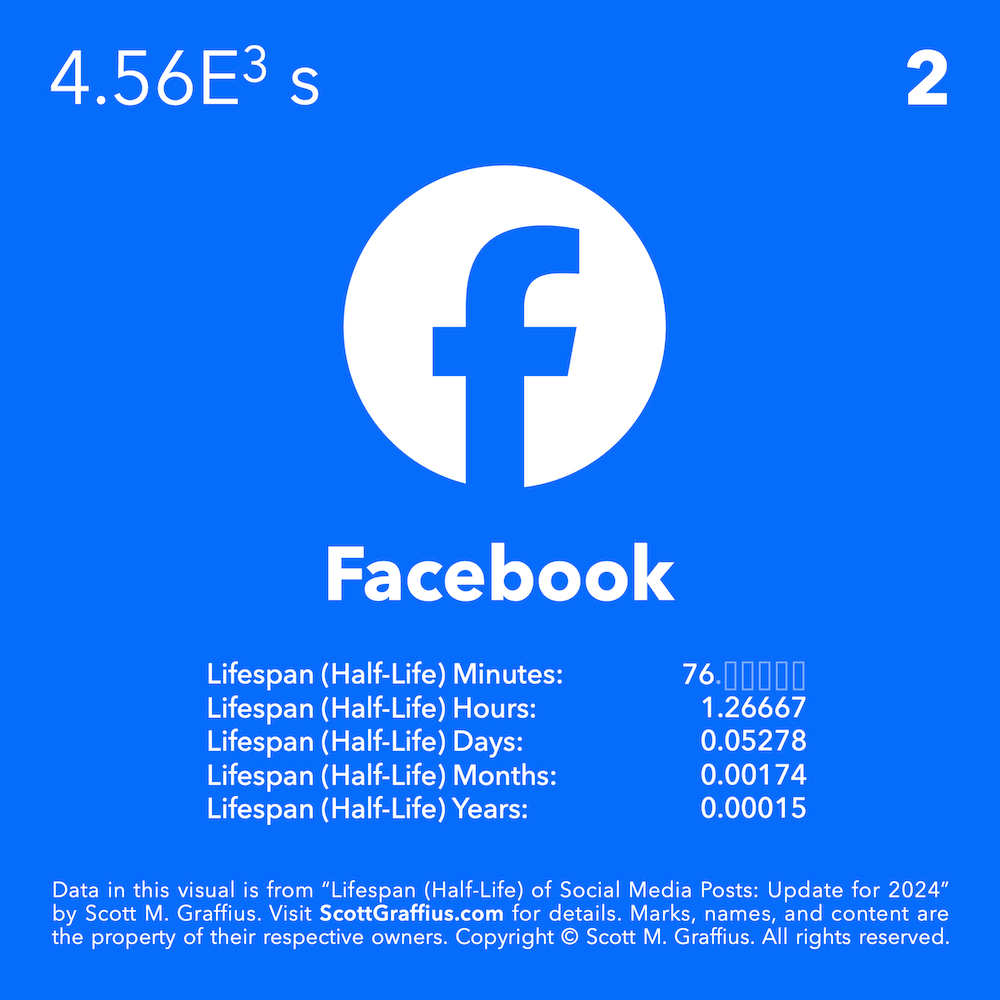
The average half-life duration for Facebook posts is 76 minutes (= 1.27 hours).A
Algorithms and other factors on platforms can change over time, potentially impacting the average half-life duration for posts. For comparison, here’s data on Facebook for 2024 along with the last two annual editions of this report:
- 2024: 76 minutes.A
- 2023: 105 minutes.B4
- 2022: 60 minutes.B5


Instagram is a photo and video-sharing service owned by Meta Platforms. The service allows users to upload media that can be edited with filters and organized by hashtags and geographical tagging. Users can browse other users’ content by tag and location, view trending content, like photos, and follow other users to add their content to a personal feed. Instagram has 2,000,000,000 (2.00 billion) active users.B3
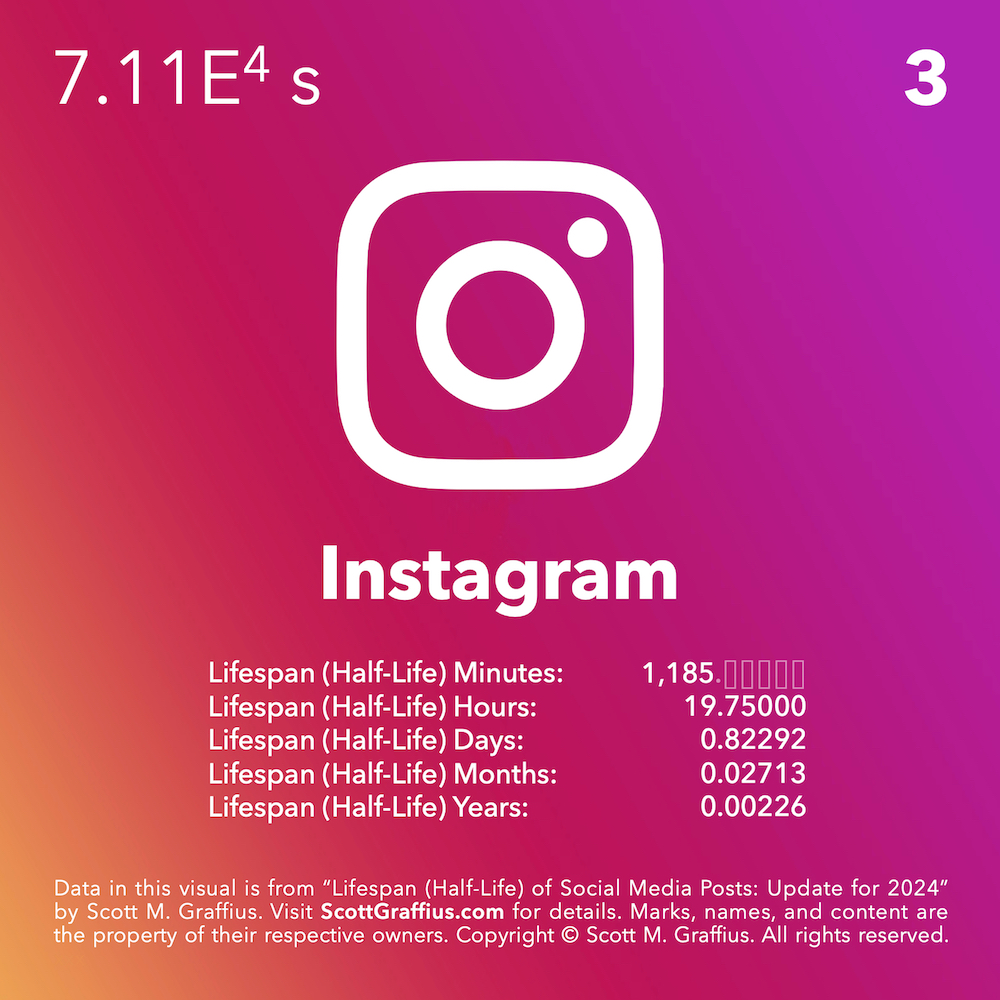
The average half-life duration for Instagram posts is 1,185 minutes (= 19.75 hours).A
Algorithms and other factors on platforms can change over time, potentially impacting the average half-life duration for posts. For comparison, here’s data on Instagram for 2024 along with the last two annual editions of this report:
- 2024: 1,185 minutes (= 19.75 hours).A
- 2023: 1,200 minutes (= 20.00 hours).B4
- 2022: 1,170 minutes (= 19.50 hours).B5


LinkedIn is a business and employment-oriented online service. It's a wholly-owned subsidiary of Microsoft. LinkedIn claims to have 875,000,000+ (875 million) users.B6 However, it does not report how many of those users are active users. It’s estimated that 424,000,000 (424 million) are active users.B7

The average half-life duration for LinkedIn posts is 1,458 minutes (= 24.30 hours).A
Algorithms and other factors on platforms can change over time, potentially impacting the average half-life duration for posts. For comparison, here’s data on LinkedIn for 2024 along with the last two annual editions of this report:
- 2024: 1,458 minutes (= 24.30 hours).A
- 2023: 1,440 minutes (= 24.00 hours).B4
- 2022: 1,440 minutes (= 24.00 hours).B5


YouTube
YouTube is an online video-sharing platform. It's owned by Google, and it's the second most visited website, after Google Search. YouTube has 2,490,000,000 (2.49 billion) active users.B3
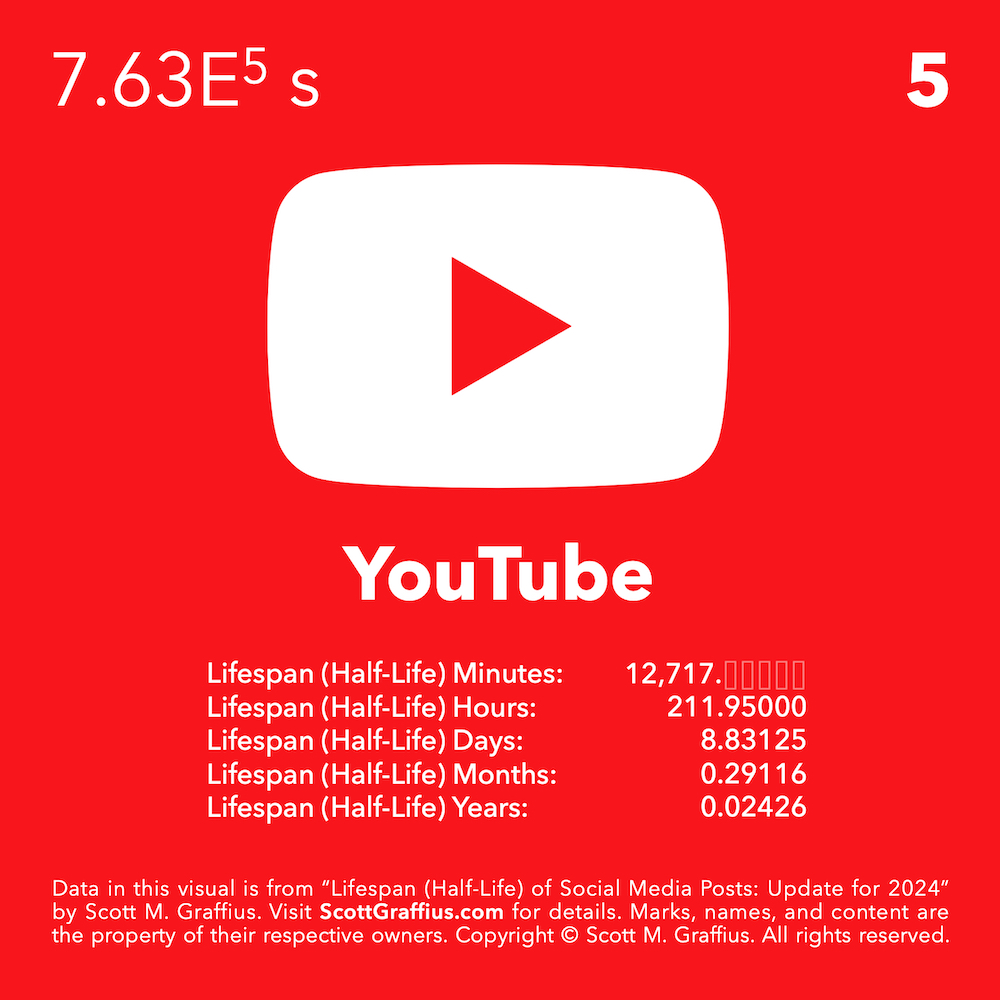
The average half-life duration for YouTube posts is 12,717 minutes (= 8.83 days).A
Algorithms and other factors on platforms can change over time, potentially impacting the average half-life duration for posts. For comparison, here’s data on YouTube for 2024 along with the last two annual editions of this report:
- 2024: 12,717 minutes (= 211.95 hours = 8.83 days).A
- 2023: 12,672 minutes (= 211.20 hours = 8.80 days).B4
- 2022: 8,640 minutes (= 144.00 hours = 6.00 days).B5


Pinterest is an image-sharing service designed to enable the saving and discovery of information (specifically "ideas") on the internet using images — and on a smaller scale, videos — in the form of pinboards. The platform is operated by Pinterest, Inc. It has 465,000,000 (465 million) active users.B3
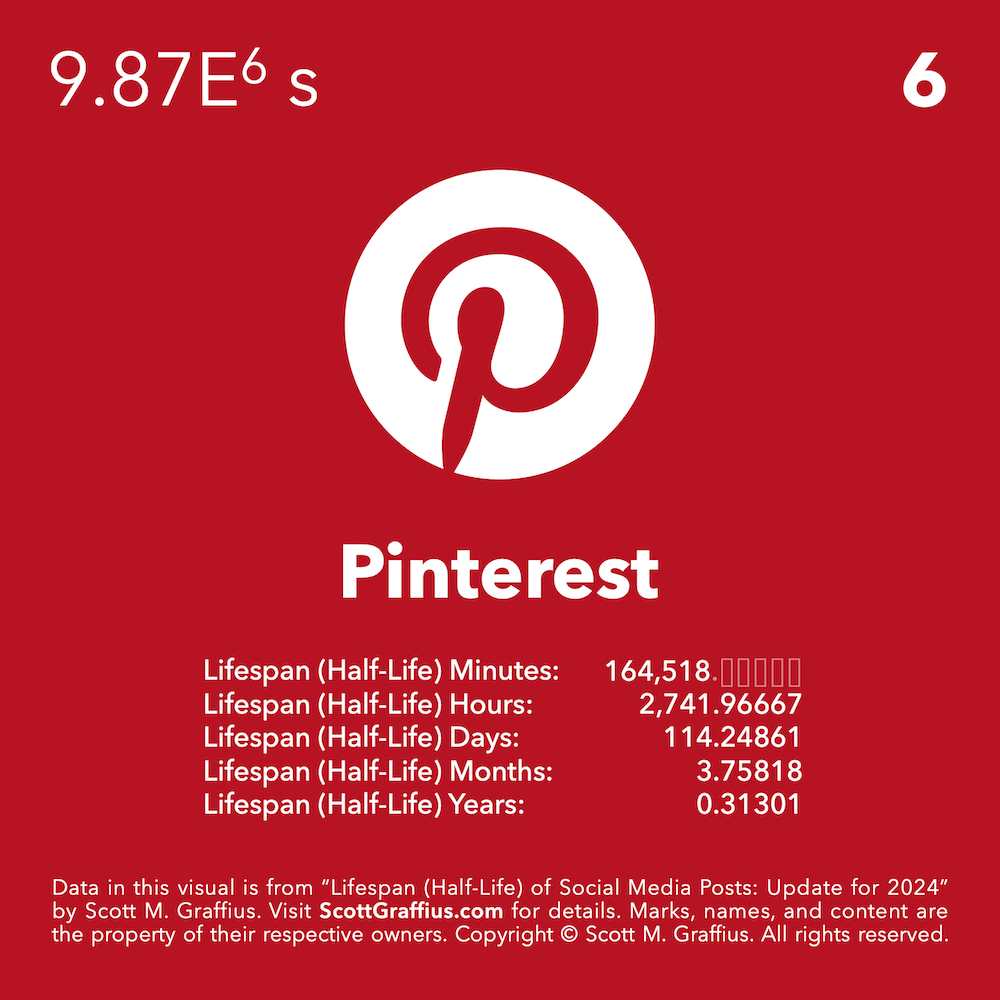
The average half-life duration for Pinterest posts is 164,518 minutes (= 3.76 months).A
Algorithms and other factors on platforms can change over time, potentially impacting the average half-life duration for posts. For comparison, here’s data on Pinterest for 2024 along with the last two annual editions of this report:
- 2024: 164,518 minutes (= 2,741.97 hours = 114.25 days = 16.32 weeks = 3.76 months).A
- 2023: 164,270 minutes (= 2,737.83 hours = 114.08 days = 16.30 weeks = 3.76 months).B4
- 2022: 164,270 minutes (= 2,737.83 hours = 114.08 days = 16.30 weeks = 3.76 months).B5

Blogs
Blogs (a truncation of "weblogs") are discussion or informational websites consisting of discrete, often diary-style entries. Up until 2009, blogs were usually the work of individuals and each typically covered a single topic. In the 2010s, multi-author blogs (MABs) from media outlets and others emerged. In addition to featuring the writings of multiple authors, MABs often span a range of topics. It is estimated that there are over 600,000,000 (600 million) blogs.B8

The average half-life duration for blog posts is 1,022,997 minutes (= 1.95 years).A
The functionality of blogs and other factors can change over time, potentially impacting the average half-life duration for posts. For comparison, here’s data on blogs for 2024 along with the prior annual edition of this report (note: this research started reporting on blogs in 2023):
- 2024: 1,022,997 minutes (1.95 years).A
- 2023: 1,051,200 minutes (2.00 years).B4


Conclusion
Social media platforms — such as Snapchat, X, Facebook, Instagram, LinkedIn, YouTube, Pinterest, and blogs — enable people to connect with family and friends, share information and ideas, and access news and entertainment. The platforms also provide organizations with direct channels to reach and engage with their target audiences.
The relevance and engagement of posts on social media platforms have a limited lifespan. An advantageous objective metric is half-life. It’s the time it takes for a post to receive half of its total engagement (such as likes, shares, and comments). In 2018, Scott M. Graffius first published data on the lifespan (half-life) of social media posts. Algorithms and other factors on platforms change over time. For that reason, Graffius periodically updates the analysis. This report, which is based on half-life data from 37 sources, provides an update for 2024.
Social media analytics provide valuable insights that can support efforts to level-up engagement and results.B9,B10,B11,B12,B13,B14,B15 Data on the average lifespan (half-life) of posts, for example, can help inform strategic and tactical decisions such as the frequency and scheduling of posts.


Graffius’ Research is Widely Cited
Scientists, researchers, journalists, academics, YouTubers, podcasters, SEO experts, analysts, businesses, and others have featured and used prior — 2023 and earlier — editions of Scott M. Graffius’ “Lifespan (Half-Life) of Social Media Posts” research. Here are a few examples:
- Bensley, Robert J., & Brookins-Fisher, Jodi (2023, December 14). Community and Public Health Education Methods: A Practical Guide—Fifth Edition. Burlington, MA: Jones & Bartlett Learning. [The authors cover Graffius’ work in Chapter 10 (Using Social Media) and list Graffius’ work as reference number 84 on page 256. A link to the publication at Google Books is here: https://bit.ly/cphem-5.]
- Berkessel, Juergen (2021, October 27). How Evergreen Posting on Social Media for Podcasters Creates Growth. Season 1, Episode 9 of the Podcasting Strategy Show. Available at: https://polymash.com/evergreen-posting. [The podcast references Graffius’ research. Show notes include Graffius’ “Lifespan (Half-Life) of Social Media Posts” visual as well as a hyperlink to Graffius’ full report.]
- Burton, Taylor (2022, November 2). Social Media Marketing: Leveraging LinkedIn. Pennsylvania Bar Institute. Available at: https://go.pbi.org/blog/social-media-marketing-leveraging-linkedin. [In the article, “LinkedIn posts are shown to have a longer lifespan” is hyperlinked to Graffius’ research.]
- Center for Direct Marketing (2022, September 27). What Is the Average Lifespan of a Blog or Social Media Post? Available at: https://dmcenter.com/lifespan-of-a-post. [The article include data from Graffius and a hyperlink to his research.]
- Chowdhary, Tanish (2023, March 21). 13 Best Twitter Thread Tools to Go Viral in 2023. Geekflare. Available at: https://geekflare.com/best-twitter-thread-tools. [The article includes Graffius’ “Lifespan (Half-Life) of Social Media Posts” visual and a hyperlink to Graffius’ research.]
- Confederation of European Waste-to-Energy Plants (CEWEP) (2023, June 15). The Power of Social Media and How to Use It. 10th CEWEP Waste-to-Energy Congress, 14th - 16th June 2023, Berlin. Available at: https://www.cewep.eu/congress2023presentations/ and https://www.cewep.eu/wp-content/uploads/2023/06/4.1-Monika-Michalska.pdf. [CEWEP Congress presentation slide 9 featured Graffius’ visual, representing a summary of his research findings.]
- Degraux, Xavier (2022, November 5). Quelle est la Durée d’un Post sur Twitter, Instagram, LinkedIn. Available at: https://www.xavierdegraux.be/quelle-est-la-duree-dun-post-sur-twitter-instagram-linkedin. [In his article, Xavier Degraux — a social networks and content marketing consultant based in Belgium — discussed Graffius' work and provided a hyperlink to the research. Here's the title in English: How Long is a Post on Twitter, Instagram, LinkedIn.]
- Encompass Online Marketing (2023, March 15). How Often Should You Publish New Content? Available at: https://encompassonline.ca/blog/how-often-should-you-publish-new-content. [Among other points, the article references the lifespan of tweets and has a hyperlink to Graffius’ research.]
- Fallah, Georges (2023, December 18). The Best Times to Post on Social Media. Available at: https://www.vbout.com/blog/the-best-times-to-post-on-social-media. [The article has hyperlinks to Graffius’ research.]
- Gebauer, Susanna (2022, October 25). Twitter Scheduling: How to Schedule Tweets for More Impact. Available at: https://susannagebauer.com/blog/twitter-scheduling/. [The article includes a link to Graffius' research.]
- Geyser, Werner (2023, September 20). 34 Mind-blowing Pinterest Stats for 2023. Influencer Marketing Hub. Available at: https://influencermarketinghub.com/pinterest-stats. [The article references the durations of “three months” and provides a hyperlink to Graffius’ research.]
- GoDaddy (2023, February 20). How to Do Social Media: A Guide for Small Businesses and Entrepreneurs. Available at: https://www.godaddy.com/resources/skills/how-to-do-social-media. [In discussing the lifespan of tweets, the article provides a hyperlink to Graffius’ research.]
- Gotch, Nathan (2023, December 4). How to Start an SEO Business (2024 Update). Available at: https://www.gotchseo.com/start-seo-company/. [The article includes Graffius’ “Lifespan (Half-Life) of Social Media Posts” visual and a hyperlink to Graffius’ research.]
- Hawes, C. W. (2023, January 24). Social Media Half-Life. Available at: https://www.cwhawes.com/social-media-half-life. [The article identifies Graffius’ research and has a hyperlink to it.]
- Lin, Yunduan, & Wang, Mengxin, & Zhang, Heng, & Zhang, Renyu, & Shen, Zuo-Jun Max (2021, June 9; revised 2023, June 28). Content Promotion for Online Content Platforms with the Diffusion Effect. SSRN. Available at: https://papers.ssrn.com/sol3/papers.cfm?abstract_id=3863104 and https://dx.doi.org/10.2139/ssrn.3863104. [The scientific paper mentions Graffius’ work, and it delineates his research in the References section.]
- McErlain-Naylor, Stuart (2022, March 24). Social Media for Academia - All You Need to Know [Video]. Available at: https://www.youtube.com/watch?v=Ka88MxZbU8o. [At timestamp 13:59 in the video, Dr. Stuart McErlain-Naylor displays a visual which summarizes the 2022 edition of Graffius’ research.]
- MeetEdgar (2023, April 2). Everything You Need to Know About Repeating Social Media Content. Available at: https://meetedgar.com/blog/repeating-social-media-content. [This article from social media management tool company MeetEdgar discusses the lifespan of posts and it has a hyperlink to Graffius’ research.]
- Memom, Alafiya (2023, June 14). Master the Art of Using Pinterest for Blogging in 2023. ContentStudio. Available at: https://blog.contentstudio.io/pinterest-for-blogging. [The article rounds up the half-life of Pinterest pins as “4 months” and it includes a hyperlink to Graffius’ research.]
- Metricool (2023, October 31). YouTube Marketing in 2023. Available at: https://metricool.com/youtube-marketing. [The article includes “According to Scott Graffius’s data ...” and a hyperlink to Graffius’ research.]
- Patel, Neil (2023, May 23). 18 Powerful Twitter Marketing Tips [That Actually Work]. Neil Patel. Available at: https://neilpatel.com/blog/twitter-marketing-tips. [In the article, “The average lifespan of one tweet” has a hyperlink to Graffius’ research.]
- Pitzalis, Josh (2022, November 21). Finding Social Media Calendar Ideas for Twitter. Chirr App. Available at: https://getchirrapp.com/how-to/find. [The article references the half-life of a tweet and has a hyperlink to Graffius’ research.]
- Pugalia, Akash, & Lalani, Farah (2023, September 29). Digital Safety: How a Multi-Faceted Approach Can Help Tackle Real-World Harm. World Economic Forum. Available at: https://www.weforum.org/agenda/2023/09/digital-safety-multi-faceted-approach-tackle-real-world-harm. [The Proceedings of the National Academy of Sciences (PNAS) included data by Graffius on the half-life of social media. The World Economic Forum covered that PNAS study in their article.]
- Rainey, Clint (2023, August 15). Social Media’s Toxic Impact Can Last Up to 8 Days. This Behavioral Scientist’s Solution Might Surprise You. Available at: https://www.fastcompany.com/90939081/social-media-toxic-impact-content-moderation-solution-behavior-science. [The Proceedings of the National Academy of Sciences (PNAS) included Graffius’ research data on the half-life of social media. Fast Company covered that PNAS publication — and summarized Graffius’ data from it — in their article.]
- Rynek Pro (2023, June 26). Długość Życia Postów (Half-Life) w Mediach Społecznościowych w 2023 Roku. Available at: https://rynek.pro/half-life-dlugosc-zycia-postow/#pll_switcher. [Rynek Pro, a Poland-based advertising agency, featured Graffius’ research in their article. Here’s the title in English: Life Expectancy of Posts (Half-Life) in Social Media in 2023.]
- Schneider, Philipp J., & Rizoiu, Marian-Andrei (2023, August 22). The Effectiveness of Moderating Harmful Online Content. Proceedings of the National Academy of Sciences of the United States of America, 120 (34): e2307360120. Available at: https://www.pnas.org/doi/abs/10.1073/pnas.2307360120. DOI: 10.1073/pnas.2307360120. [The scientific paper references Graffius’ “Lifespan (Half-Life) of Social Media Posts” research and uses his data.]
- Strozyk, Kaylee (2023, November 3). 11 Tips on How to Use Pinterest for Real Estate. Fit Small Business. Available at: https://fitsmallbusiness.com/how-to-use-pinterest-for-real-estate-agents. [The article references that the half-life of Pinterest pins is “about 3.75 months.” Selecting the respective hyperlink brings up Graffius’ research.]
- Thailand TV News (2022, August 16). Half-Life of Each Social Media Post. Available at: https://thailandtv.news/half-life-of-each-social-media-post-thumbsup. [The article incorporates data from Graffius’ work and it has a hyperlink to his research.]
- The Tech Reps (2023, January 23). SEO or Social Media Marketing, Which is Better for Sales? [video]. Available at: https://www.youtube.com/watch?v=aVmQdHDXCrw. [The Tech Reps used Graffius’ “Lifespan (Half-Life) of Social Media Posts” visual as the background image in their video.]
- Two Rivers Marketing (2020, December 9). 8 Social Media Channels and Tactics to Consider Adding to Your Marketing Mix. Available at: https://www.tworiversmarketing.com/blog/8-social-media-channels-and-tactics-to-consider-adding-to-your-marketing-mix. [The article references the lifespan of posts and has a hyperlink to Graffius’ research.]
- Walters, Christy (2023, May 4). How To Curate Content for LinkedIn: Handpick Your Next Post. CopyPress. Available at: https://www.copypress.com/kb/social-media-promotion/curate-content-for-linkedin. [The article discusses the lifespan of a LinkedIn post and has a hyperlink to Graffius’ research.]
- And many more.
Graffius appreciates the coverage of his research.


References/Sources
References/sources are organized into two sections - A and B.
A. Here are the sources related to the lifespan (half-life) of social media posts:
- A1. Adobe
- A2. Association for the Advancement of Artificial Intelligence
- A3. Bit(dot)ly
- A4. Business Insider
- A5. Business Standard
- A6. Cornell University
- A7. Emeritus
- A8. Espirian
- A9. Exceptional PPM and PMO Solutions
- A10. Fanbooster (Traject)
- A11. Fast Company
- A12. Forbes
- A13. Google
- A14. Halverson Group
- A15. IEEE
- A16. Ignite Social Media
- A17. Kinsta
- A18. Klout
- A19. Later
- A20. Moz
- A21. New York Times
- A22. Pinterest
- A23. Royal Town Planning Institute
- A24. Science(dot)org
- A25. Sculpt - B2B Social Media Agency
- A26. Simply Measured
- A27. Snapchat
- A28. Social Media Marketing
- A29. Social Media University—Global
- A30. Tapp Network
- A31. TechniqueHow
- A32. The Online Advertising Guide
- A33. Université de Genève
- A34. University of Akron
- A35. Washington Post
- A36. WebFX
- A37. Wiselytics
B. Here are the references for additional information (such as the number of active users on platforms, etc.; see section A for sources related to the half-life of posts):
- B1. Statista (2023, August 31). Social Media - Statistics and Facts.
- B2. Trivette, Hannah (2022, October 14). A Guide to Social Media Algorithms and SEO. Forbes.
- B3. Statista (2023, October). Most Popular Social Networks Worldwide as of October 2023.
- B4. Graffius, Scott M. (2023, January 1). Lifespan (Half-Life) of Social Media Posts: Update for 2023. Available at: https://scottgraffius.com/blog/files/social-2023.html. DOI: 10.13140/RG.2.2.19783.98722.
- B5. Graffius, Scott M. (2022, January 5). Lifespan (Half-Life) of Social Media Posts: Update for 2022. Available at: https://www.scottgraffius.com/blog/files/social-2022.html.
- B6. LinkedIn.
- B7. Macready, Hannah (2023, February 22). 47 LinkedIn Statistics You Need to Know in 2023. Hootsuite.
- B8. Ong, Si Quan (2023, January 27). 59 Blogging Statistics for 2023.
- B9. Colicev, Anatoli, & Malshe, Ashwin, & Pauwels, Koen, & O'Connor, Peter (2018). Improving Consumer Mindset Metrics and Shareholder Value Through Social Media: The Different Roles of Owned and Earned Media. Journal of Marketing, 82 (1): 37-56.
- B10. Collier, Azure (2017, April 28). How to Create a Social Media Posting Schedule. Constant Contact.
- B11. IBM (n.d.). What is Social Media Analytics. Available at: https://www.ibm.com/topics/social-media-analytics.
- B12. Kanuri, V. K., & Chen, Y., & Sridhar, S. (2018). Scheduling Content on Social Media: Theory, Evidence, and Application. Journal of Marketing, 82 (6): 89-108.
- B13. Liadeli, G., & Sotgiu, F., & Verlegh, P. W. J. (2023). A Meta-Analysis of the Effects of Brands' Owned Social Media on Social Media Engagement and Sales. Journal of Marketing, 87 (3): 406-427.
- B14. Perreault, Marie-Catherine, & Mosconi, Elaine (2018). Social Media Engagement: Content Strategy and Metrics Research Opportunities. Proceedings of the 51st Hawaii International Conference on System Sciences: 3568-3577.
- B15. Trunfio, Mariapina, & Rossi, Simona (2021). Conceptualising and Measuring Social Media Engagement: A Systematic Literature Review. Italian Journal of Marketing, 2021 (3):267-292.


How to Cite this Article
Graffius, Scott M. (2024, January 1). Lifespan (Half-Life) of Social Media Posts: Update for 2024. Available at: https://scottgraffius.com/blog/files/social-24.html. DOI: 10.13140/RG.2.2.21043.60965.


Permission Request Information
To request permission to use the “Lifespan (Half-Life) of Social Media Posts: Update for 2024” visual shown at the top of this article or any other material from this publication, contact Scott M. Graffius. If your request is approved, Graffius will give you an authorization/license and, if applicable, high-resolution files of the visual.

About Scott M. Graffius
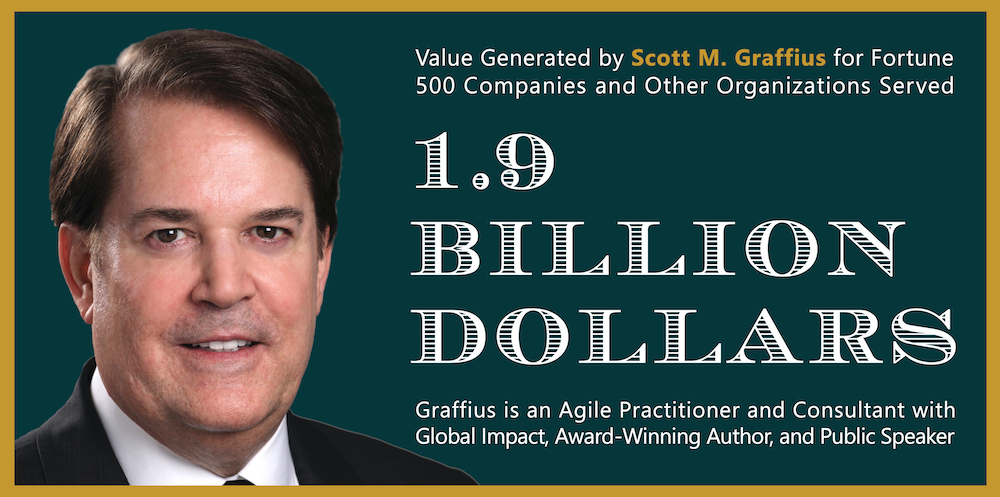
Scott M. Graffius, PMP, SA, CSP-SM, CSP-PO, CSM, CSPO, SFE, ITIL, LSSGB is an agile project management practitioner, consultant, thinker, creator, multi-award-winning author, and international public speaker. Founder and CEO of Exceptional PPM and PMO Solutions™ and subsidiary Exceptional Agility™, he has generated over $1.9 billion for Global Fortune 500 businesses and other organizations he has served. Graffius and content from his books, talks, workshops, and more have been featured and used by Microsoft, Oracle, Broadcom, Cisco, Gartner, Project Management Institute, IEEE, National Academy of Sciences, United States Department of Energy, Yale University, Tufts University, and others. He delights audiences with dynamic and engaging talks and workshops on agile project management, AI, Tech leadership, video game development, strategic alignment, the science of high performance teams, and more. To date, he's presented sessions at 89 conferences and other events across 25 countries.
His full bio is available here.
Connect with Scott on:

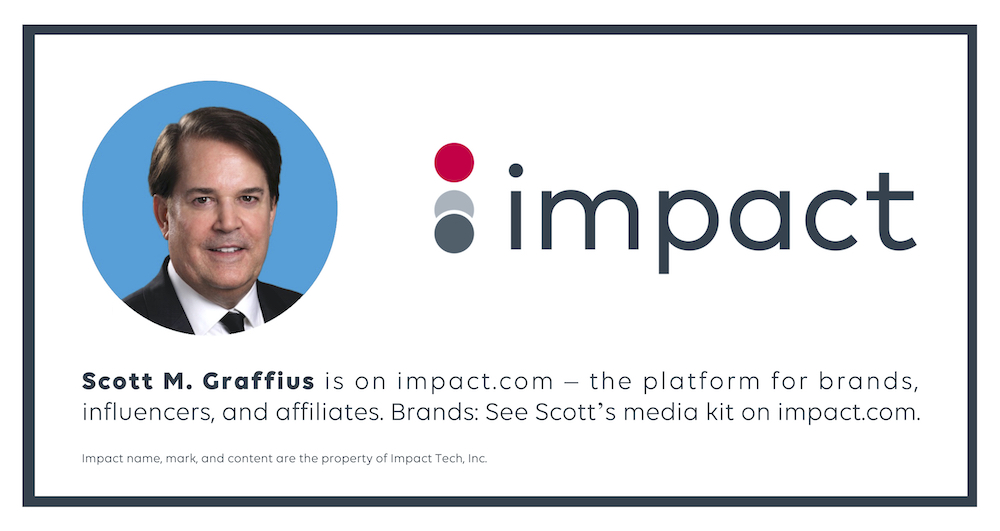

About Agile Scrum: Your Quick Start Guide with Step-by-Step Instructions

Shifting customer needs are common in today's marketplace. Businesses must be adaptive and responsive to change while delivering an exceptional customer experience to be competitive.
There are a variety of frameworks supporting the development of products and services, and most approaches fall into one of two broad categories: traditional or agile. Traditional practices such as waterfall engage sequential development, while agile involves iterative and incremental deliverables. Organizations are increasingly embracing agile to manage projects, and best meet their business needs of rapid response to change, fast delivery speed, and more.
With clear and easy to follow instructions, the multi award-winning Agile Scrum: Your Quick Start Guide with Step-by-Step Instructions book by Scott M. Graffius (Chris Hare and Colin Giffen, Technical Editors) helps the reader:
- Implement and use the most popular agile framework―Scrum;
- Deliver products in short cycles with rapid adaptation to change, fast time-to-market, and continuous improvement; and
- Support innovation and drive competitive advantage.
Hailed by Literary Titan as “the book highlights the versatility of Scrum beautifully.”
Winner of 17 first place awards.
Agile Scrum: Your Quick Start Guide with Step-by-Step Instructions is available in paperback and ebook/Kindle in the United States and around the world. Some links by country follow.
- 🇧🇷 Brazil
- 🇨🇦 Canada
- 🇨🇿 Czech Republic
- 🇩🇰 Denmark
- 🇫🇮 Finland
- 🇫🇷 France
- 🇩🇪 Germany
- 🇬🇷 Greece
- 🇭🇺 Hungary
- 🇮🇳 India
- 🇮🇪 Ireland
- 🇮🇱 Israel
- 🇮🇹 Italy
- 🇯🇵 Japan
- 🇱🇺 Luxembourg
- 🇲🇽 Mexico
- 🇳🇱 Netherlands
- 🇳🇿 New Zealand
- 🇳🇴 Norway
- 🇪🇸 Spain
- 🇸🇪 Sweden
- 🇨🇭 Switzerland
- 🇦🇪 UAE
- 🇬🇧 United Kingdom
- 🇺🇸 United States

About Agile Transformation: A Brief Story of How an Entertainment Company Developed New Capabilities and Unlocked Business Agility to Thrive in an Era of Rapid Change

Thriving in today's marketplace frequently depends on making a transformation to become more agile. Those successful in the transition enjoy faster delivery speed and ROI, higher satisfaction, continuous improvement, and additional benefits.
Based on actual events, Agile Transformation: A Brief Story of How an Entertainment Company Developed New Capabilities and Unlocked Business Agility to Thrive in an Era of Rapid Change provides a quick (60-90 minute) read about a successful agile transformation at a multinational entertainment and media company, told from the author's perspective as an agile coach.
The award-winning book by Scott M. Graffius is available in paperback and ebook/Kindle in the United States and around the world. Some links by country follow.
- 🇦🇺 Australia
- 🇦🇹 Austria
- 🇧🇷 Brazil
- 🇨🇦 Canada
- 🇨🇿 Czech Republic
- 🇩🇰 Denmark
- 🇫🇮 Finland
- 🇫🇷 France
- 🇩🇪 Germany
- 🇬🇷 Greece
- 🇮🇳 India
- 🇮🇪 Ireland
- 🇯🇵 Japan
- 🇱🇺 Luxembourg
- 🇲🇽 Mexico
- 🇳🇱 Netherlands
- 🇳🇿 New Zealand
- 🇪🇸 Spain
- 🇸🇪 Sweden
- 🇨🇭 Switzerland
- 🇦🇪 United Arab Emirates
- 🇬🇧 United Kingdom
- 🇺🇸 United States

The short link for this article is: https://bit.ly/life-2024


Post-Publication Notes
Update on 25 March 2024
At the time of publication, a graphic on the average lifespan (half-life) of posts on X indicated “7.71667” under hours. That typo was corrected to read “0.71667.” The change was implemented in this article on 25 March 2024.
Update on 6 January 2025
Algorithms and other factors on social media platforms change over time. For that reason, Scott M. Graffius periodically updates his 'Lifespan (Half-Life) of Social Media Posts' research. The most current edition is here.

© Copyright 2024 Scott M. Graffius. All rights reserved. This material may not be published, broadcast, rewritten or redistributed without the express written permission of Scott M. Graffius.

Lifespan (Half-Life) of Social Media Posts: Update for 2025

Download PDF of Article | High Resolution Files of Visual: JPG and PNG


Introduction
People and organizations use digital communication to reach and engage target audiences and promote content. This is digital marketing, and it includes email, social media, web-based advertising, and text and multimedia messages.
Social media marketing is an increasingly vital aspect of digital marketing. It includes creating, curating, and sharing content on platforms such as Snapchat, TikTok, X (formerly Twitter), Facebook, Reddit, Instagram, LinkedIn, podcasts, YouTube, Pinterest, and blogs. Beyond posting, it involves engaging with audiences, fostering community interactions, and more. These platforms enable people to access, share, and interact with content while also connecting with family, friends, and others. For businesses, social media marketing provides direct channels to reach and engage with target audiences effectively. When well-executed, it delivers multiple benefits, including:
- Global engagement: With 5,170,000,000 (5.17 billion) active social media users worldwideB1, the potential audience is vast.
- Enhanced brand visibility: Boost awareness and reach in the marketplace.
- Stronger customer connections: Foster meaningful engagement with your audience.
- Increased website traffic: Drive more visitors to your online platforms.
- Better search engine rankings: Improve visibility in search results.
- And more: Unlock additional opportunities to grow your brand.
Content on social media typically has a short window of relevance and engagement. An advantageous objective metric is half-life. It’s the time it takes for a post to receive half of its total engagement (such as likes, shares, and comments). Data can help inform strategic and tactical decisions, such as the frequency and scheduling of posts.
Others’ reports on the longevity of social media content often rely on anecdotal evidence, limited datasets, or otherwise non-robust methodology. These common constraints can result in findings that are non-representative, inaccurate, or unreliable.
In 2018, Scott M. Graffius first published data on the lifespan (half-life) of social media posts, using a robust methodology that analyzed a broad set of data from multiple sources. Given that algorithms and other factors on platforms change over timeB2,B25,B26, Graffius periodically updates his analysis.
This article provides the 'Lifespan (Half-Life) of Social Media Posts: Update for 2025.' It covers Snapchat, TikTok, X, Facebook, Reddit, Instagram, LinkedIn, podcasts (audio and video formats with engagement functionality), YouTube, Pinterest, and blogs (with engagement functionality).
Findings were derived from an extensive analysis of over 5,000,000 social media posts and 225 podcasts, aggregated from multiple sources, including APIs, proprietary commercial datasets, academic and research consortia databases, publicly shared datasets, governmental and non-governmental organizational data repositories, and more.A1
The collective dataset includes data from 1 January 2024 through 31 December 2024 (with retrospective data from antecedent blogging platforms) on diverse entities, including individuals (from those with a relatively small number of followers/subscribers to influencers), businesses (from small to large), professional associations, educational institutions, and others. Entities are represented proportionately, reflecting the distribution in the digital ecosystem.A1
This comprehensive, multidimensional approach yields a robust and representative sampling of posts, providing a broad and deep scope of analysis.A1
For more insights and details, refer to the Frequently Asked Questions (FAQs) section.


Main Section of Article

As detailed next, the average half-life of posts varies by social media platform.

Snapchat
Snapchat is a multimedia messaging app developed by Snap Inc., renowned for its fleeting content where images, videos, and messages vanish shortly after being viewed. Beyond its ephemeral nature, Snapchat offers features like Stories, Discover, augmented reality (AR) filters, and Snap Map. It has 800,000,000 (800 million) active users.B3

The average half-life duration for Snapchat posts is 0 minutes.A1 Exceptions apply. Content may disappear instantly or live up to 24 hours (even longer in certain cases) depending on the message type, user settings, and other details.
Algorithms and other factors on platforms can change over time, potentially impacting the average half-life duration for posts. For comparison, here’s data on Snapchat for 2025 along with the previous two annual editions of this report:
- 2025: 0 minutes (exceptions apply).A1
- 2024: 0 minutes (exceptions apply).B4
- 2023: 0 minutes (exceptions apply).B5
See the FAQs for more insights about Snapchat.


TikTok
TikTok is a leading platform for ephemeral content, characterized by its fleeting nature where videos typically last only a short time before disappearing. The platform's emphasis on short clips aligns with the growing trend of instant decay in digital media, allowing creators to share spontaneous moments and real-time updates without the pressure of crafting polished, permanent content. TikTok has 1,582,000,000 (1.58 billion) active users.B3

The average half-life duration for TikTok posts is 0 minutes.A1 However, exceptions apply. Videos with unique, compelling content or celebrity involvement can go viral, significantly extending their visibility and engagement.
TikTok was added to this report in 2025. It did not appear in the prior two annual editions.
- 2025: 0 minutes (exceptions apply).A1
- 2024: TikTok did not appear in the 2024 report.B4
- 2023: TikTok did not appear in the 2023 report.B5
See the FAQs for a disclaimer and more insights about TikTok.


X
X is a microblogging and social networking service owned by X Corp., where users post and interact with messages known as “tweets” or “X posts.” The following from X encapsulates its vision, mission, and goals: "We're building the world's most trusted public town square—and we pride ourselves on our commitment to protecting free speech within the boundaries of the law. Beyond that, we aim to increase unregretted user minutes on our platform, and make it the best place on the internet for creators to share content and make money." B6 X has 611,000,000 (611 million) active users.B3

The average half-life duration for posts on X is 49 minutes.A1
Algorithms and other factors on platforms can change over time, potentially impacting the average half-life duration for posts. For comparison, here’s data on X for 2025 along with the previous two annual editions of this report:
- 2025: 49 minutes.A1
- 2024: 43 minutes.B4
- 2023: 24 minutes.B5
See the FAQs for more insights about X.


Facebook is an online social media and social networking service owned by Meta Platforms. It has 3,065,000,000 (3.06 billion) active users.B3

The average half-life duration for Facebook posts is 81 minutes = 1.35 hours.A1
Algorithms and other factors on platforms can change over time, potentially impacting the average half-life duration for posts. For comparison, here’s data on Facebook for 2025 along with the previous two annual editions of this report:
- 2025: 81 minutes = 1.35 hours.A1
- 2024: 76 minutes = 1.27 hours.B4
- 2023: 105 minutes = 1.75 hours.B5
See the FAQs for more insights about Facebook.


Reddit, sometimes called 'the front page of the internet,' is a dynamic social media platform where users engage in discussions across over 100,000 topic-specific communities called subreddits. Its innovative upvote and downvote system empowers users to curate content collaboratively, promoting high-quality posts and comments while minimizing the visibility of less relevant ones. Since its launch in 2005, Reddit has grown into a diverse ecosystem encompassing everything from breaking news and in-depth discussions to memes and niche hobbies. Its participatory culture and vast range of content make it a cornerstone of online social interaction and a go-to platform for discovering and connecting with communities of shared interests. Reddit is estimated to have over 1,000,000,000 (1.00 billion) active users.B21

The average half-life duration for Reddit posts is 155 minutes = 2.58 hours.A1
Reddit was added to this report in 2025. It did not appear in the prior two annual editions.
- 2025: 155 minutes = 2.58 hours.A1
- 2024: Reddit did not appear in the 2024 report.B4
- 2023: Reddit did not appear in the 2023 report.B5
See the FAQs for more insights about Reddit.


Instagram is a photo and video-sharing social network owned by Meta Platforms. It enables users to upload media, which can be enhanced with filters, captions, and stickers, and organized using hashtags and location tags. Users can follow other accounts and engage by liking posts, sharing, and commenting to curate their feed. Instagram has 2,000,000,000 (2.00 billion) active users.B3

The average half-life duration for Instagram posts is 1,143 minutes = 19.04 hours.A1
Algorithms and other factors on platforms can change over time, potentially impacting the average half-life duration for posts. For comparison, here’s data on Instagram for 2025 along with the previous two annual editions of this report:
- 2025: 1,143 minutes = 19.04 hours.A1
- 2024: 1,185 minutes = 19.75 hours.B4
- 2023: 1,200 minutes = 20.00 hours.B5
See the FAQs for more insights about Instagram.


LinkedIn is a business and employment-oriented online service. It's a wholly-owned subsidiary of Microsoft. It is estimated that LinkedIn has 770,970,000 (770.97 million) users.B22 However, LinkedIn does not report how many of its users are monthly active users.

The average half-life duration for LinkedIn posts is 1,426 = 23.77 hours.A1
Algorithms and other factors on platforms can change over time, potentially impacting the average half-life duration for posts. For comparison, here’s data on LinkedIn for 2025 along with the previous two annual editions of this report:
- 2025: 1,426 minutes = 23.77 hours.A1
- 2024: 1,458 minutes = 24.30 hours.B4
- 2023: 1,440 minutes = 24.00 hours.B5
See the FAQs for more insights about LinkedIn.


Podcasts
A podcast is a digital media file, available online for streaming or download. The term "podcast," coined in 2004, blends "iPod" and "broadcast." While audio podcasts dominate the medium, video podcasts, or vodcasts, have gained traction by integrating visual elements to boost engagement on platforms like YouTube. There are over 3,470,000 (3.47 million) podcasts.B23

The average half-life duration for posts on podcast platforms with engagement functionality is 9,625 minutes = 6.68 days.A1
Podcasts were added to this report in 2025. It did not appear in the prior two annual editions.
- 2025: 9,625 minutes = 6.68 days.A1
- 2024: Podcasts did not appear in the 2024 report.B4
- 2023: Podcasts did not appear in the 2023 report.B5
See the FAQs for more insights about podcasts.


YouTube
YouTube is an online video-sharing platform. It's owned by Google, and it's the second most visited website, after Google Search. YouTube has 2,504,000,000 (2.50 billion) active users.B3

The average half-life duration for YouTube posts is 13,929 minutes = 9.67 days.A1
Algorithms and other factors on platforms can change over time, potentially impacting the average half-life duration for posts. For comparison, here’s data on YouTube for 2025 along with the previous two annual editions of this report:
- 2025: 13,929 minutes = 9.67 days.A1
- 2024: 12,717 minutes = 8.83 days.B4
- 2023: 12,672 minutes = 8.80 days.B5
See the FAQs for more insights about YouTube.


Pinterest is a visual discovery and bookmarking platform that allows users to find, post, save, and organize ideas from the internet through images, videos, and links, presented as 'pins' on customizable boards. Operated by Pinterest, Inc., the platform serves as a hub for inspiration across categories such as fashion, home décor, recipes, and more, while also supporting content sharing and e-commerce integration. It has 498,000,000 (498 million) active users.B3

The average half-life duration for Pinterest posts is 169,789 minutes = 3.88 months.A1
Algorithms and other factors on platforms can change over time, potentially impacting the average half-life duration for posts. For comparison, here’s data on Pinterest for 2025 along with the previous two annual editions of this report:
- 2025: 169,789 minutes = 3.88 months.A1
- 2024: 164,518 minutes = 3.76 months.B4
- 2023: 164,270 minutes = 3.75 months.B5
See the FAQs for more insights about Pinterest.


Blogs
Blogs (a truncation of "weblogs") are discussion or informational websites consisting of discrete, often diary-style entries. Up until 2009, blogs were usually the work of individuals and each typically covered a single topic. In the 2010s, multi-author blogs (MABs) from media outlets and others emerged. In addition to featuring the writings of multiple authors, MABs frequently span a range of topics. It is estimated that there are over 600,000,000 (600 million) blogs.B8,B24

The average half-life duration for posts on blog platforms with engagement functionality is 1,037,340 minutes = 1.97 years.A1
Algorithms and other factors on platforms can change over time, potentially impacting the average half-life duration for posts. For comparison, here’s data on blogs for 2025 along with the previous two annual editions of this report:
- 2025: 1,037,340 minutes = 1.97 years.A1
- 2024: 1,022,997 minutes = 1.95 years.B4
- 2023: 1,051,200 minutes = 2.00 years.B5
See the FAQs for more insights about blogs.


Conclusion
Social media platforms—such as Snapchat, TikTok, X, Facebook, Reddit, Instagram, LinkedIn, podcasts, YouTube, Pinterest, and blogs—enable people to access, share, and interact with content while also connecting with family, friends, and others. The platforms also provide organizations with direct channels to reach and engage with their target audiences.
The relevance and engagement of social media posts have a limited lifespan. An advantageous objective metric is half-life. It’s the time it takes for a post to receive half of its total engagement (such as likes, shares, and comments). In 2018, Scott M. Graffius first published data on the lifespan (half-life) of social media posts. Algorithms and other factors on platforms change over time. For that reason, Graffius periodically updates his analysis. This report, which is based extensive study of over 5,000,000 social media posts and 225 podcasts aggregated from multiple sourcesA1, provides the update for 2025.
Social media analytics offer valuable insights that can support efforts to level up engagement and results.B9,B10,B11,B12,B13,B14,B15 Data on the average half-life of posts can help inform strategic and tactical decisions such as the frequency and scheduling of posts.
Read on for:
- Frequently Asked Questions (FAQs),
- Coverage of Graffius’ Research,
- Sources/References,
- About Scott M. Graffius
- How to Cite This Article,
- and more.


Frequently Asked Questions (FAQs)
FAQ 01. What is Social Media?
Social media refers to digital platforms and related technologies that enable users to create, share, and interact with content and connect with others in virtual communities. Leading dictionaries support that relatively broad characterization.
- Cambridge Dictionary: "Websites and computer programs that allow people to communicate and share information, opinions, pictures, videos, etc. on the internet, especially social networking websites."B18
- Britannica Dictionary: "Forms of electronic communication (such as Web sites) through which people create online communities to share information, ideas, personal messages, etc."B19
- Dictionary.com: "Websites and other online means of communication that are used by large groups of people to share information and to develop social and professional contacts."B20
Summarized, the key characteristics of social media include:
- User-generated content.
- Multimedia sharing (such as text, images, audio, or videos).
- Interactive engagement features (such as comments, likes, or shares).
FAQ 02. What platforms are included in this 2025 edition of the research?
This 2025 update covers Snapchat, TikTok, X, Facebook, Reddit, Instagram, LinkedIn, podcasts (audio and video formats with engagement functionality), YouTube, Pinterest, and blogs (with engagement functionality).
FAQ 03. Why exactly are posts on Snapchat a form of social media?
Further to FAQ items 1 and 2, posts on Snapchat are aligned with the core principles of social media by facilitating user-generated content, multimedia sharing, and interactive engagement. Here are the related definitive characteristics of Snapchat:
- User-generated content: Users create personal stories and snaps.
- Multimedia sharing: Allows sharing of photos and short videos.
- Interactive features: Users can reply to snaps, react with emojis, and send direct messages.
FAQ 04. Why exactly are posts on TikTok a form of social media?
Further to FAQ items 1 and 2, posts on TikTok are aligned with the core principles of social media by facilitating user-generated content, multimedia sharing, and interactive engagement. Here are the related definitive characteristics of TikTok:
- User-generated content: Users create and upload short videos.
- Multimedia sharing: Primarily focused on video content.
- Interactive features: Allows comments, likes, and shares on videos.
FAQ 05. Why exactly are posts on X a form of social media?
Further to FAQ items 1 and 2, posts on X are aligned with the core principles of social media by facilitating user-generated content, multimedia sharing, and interactive engagement. Here are the related definitive characteristics of X:
- User-generated content: Users post tweets and threads.
- Multimedia sharing: Supports text, images, GIFs, and videos.
- Interactive features: Enables retweets, likes, and replies.
FAQ 06. Why exactly are posts on Facebook a form of social media?
Further to FAQ items 1 and 2, posts on Facebook are aligned with the core principles of social media by facilitating user-generated content, multimedia sharing, and interactive engagement. Here are the related definitive characteristics of Facebook:
- User-generated content: Users create posts, stories, and events.
- Multimedia sharing: Supports text, images, videos, and live streaming.
- Interactive features: Offers likes, comments, shares, and reactions.
FAQ 07. Why exactly are posts on Reddit a form of social media?
Further to FAQ items 1 and 2, posts on Reddit are aligned with the core principles of social media by facilitating user-generated content, multimedia sharing, and interactive engagement. Here are the related definitive characteristics of Reddit:
- User-generated content: Users submit posts and create subreddits.
- Multimedia sharing: Allows text posts, images, videos, and links.
- Interactive features: Includes upvotes/downvotes, comments, and awards.
FAQ 08. Why exactly are posts on Instagram a form of social media?
Further to FAQ items 1 and 2, posts on Instagram are aligned with the core principles of social media by facilitating user-generated content, multimedia sharing, and interactive engagement. Here are the related definitive characteristics of Instagram:
- User-generated content: Users post photos, videos, and stories.
- Multimedia sharing: Focuses on visual content (images and videos).
- Interactive features: Enables likes, comments, and direct messaging.
FAQ 09. Why exactly are posts on LinkedIn a form of social media?
Further to FAQ items 1 and 2, posts on LinkedIn are aligned with the core principles of social media by facilitating user-generated content, multimedia sharing, and interactive engagement. Here are the related definitive characteristics of LinkedIn:
- User-generated content: Users create profiles and post professional content.
- Multimedia sharing: Supports text posts, articles, images, and videos.
- Interactive features: Allows connections, likes, comments, and endorsements.
FAQ 10. Why exactly are posts on podcast platforms a form of social media?
Further to FAQ items 1 and 2, posts on podcast platforms with engagement functionality are aligned with the core principles of social media by facilitating user-generated content, multimedia sharing, and interactive engagement. Here are the related definitive characteristics of podcasts:
- User-generated content: Creators produce and upload audio or video episodes.
- Multimedia sharing: It can include both audio-only content or video formats.
- Interactive features: Listeners/viewers can rate, review episodes, or otherwise comment on them.
FAQ 11. Why exactly are posts on YouTube a form of social media?
Further to FAQ items 1 and 2, posts on YouTube are aligned with the core principles of social media by facilitating user-generated content, multimedia sharing, and interactive engagement. Here are the related definitive characteristics of YouTube:
- User-generated content: Users create and upload videos.
- Multimedia sharing: Primarily video-based platform.
- Interactive features: Allows likes, comments, subscriptions, and sharing.
FAQ 12. Why exactly are posts on Pinterest a form of social media?
Further to FAQ items 1 and 2, posts on Pinterest are aligned with the core principles of social media by facilitating user-generated content, multimedia sharing, and interactive engagement. Here are the related definitive characteristics of Pinterest:
- User-generated content: Users create boards and pin content.
- Multimedia sharing: Focuses on image and video sharing.
- Interactive features: Enables re-pins, likes, and comments.
FAQ 13. Why exactly are posts on blog platforms a form of social media?
Further to FAQ items 1 and 2, posts on blog platforms with engagement functionality are aligned with the core principles of social media by facilitating user-generated content, multimedia sharing, and interactive engagement. Here are the related definitive characteristics of blogs:
- User-generated content: Authors create and publish blog posts.
- Multimedia sharing: It can include text, images, videos, and audio.
- Interactive features: Readers can comment on posts or share them.
FAQ 14. What is the half-life of social media posts?
The half-life is the time it takes for a post to receive half of its total engagement, such as likes, shares, and comments. It’s an advantageous objective metric for assessing content.
FAQ 15. Why is half-life important in social media strategy?
Half-life provides an objective metric to inform strategic and tactical decisions, such as the frequency and scheduling of posts.
FAQ 16. What factors can impact the half-life of social media?
Posts can be influenced by multiple elements. Here are ten:
- Content Relevance: Posts that resonate with audience interests and needs will likely have a longer half-life.
- Timing of Post: The timing of your post can significantly affect its half-life. Posting at times when your audience is most active and likely to engage can extend the lifespan of your post.
- Engagement Level: Posts with higher initial engagement will likely remain relevant and visible longer.
- Quality of Visuals: Posts with high-quality visuals, such as images, videos, or infographics, tend to capture more attention and have a longer lifespan on social media.
- Use of Hashtags: Strategic use of hashtags can increase the discoverability of your post and extend its reach, thus impacting its half-life.
- Platform Algorithm: Each social media platform has its own algorithm that determines the visibility and reach of posts. Understanding and optimizing for these algorithms can affect the half-life of your posts.
- Audience Engagement: The level of engagement from your audience, including likes, comments, shares, and click-through rates, can influence the half-life of your post. Higher engagement indicates higher relevance and longevity.
- Post Frequency: The frequency at which you post content can impact the half-life of individual posts. Spacing posts out can allow each one to receive more attention over time.
- Content Format: Different content formats, such as text-only posts, images, videos, and interactive content, may have varying half-lives based on their appeal and engagement potential.
- External Events and Trends: External events, holidays, trends, and news topics can affect the relevance and visibility of your posts. Leveraging timely content can extend the half-life of your posts by tapping into current conversations and interests.
FAQ 17. What data sources were used for the 2025 update?
The analysis drew from over 5,000,000 social media posts and 225 podcasts. Data sources included APIs, proprietary commercial datasets, academic and research consortia databases, publicly shared datasets, governmental and non-governmental organizational data repositories, and more.
FAQ 18. What dates does the 2025 update cover?
The update includes data from 1 January 2024 through 31 December 2024 and retrospective data from antecedent blogging platforms.
FAQ 19. Who is represented in the dataset used for the research?
The dataset represents a diverse range of entities, including individuals (from small accounts to influencers), businesses (small to large), professional associations, educational institutions, and more. The representation reflects the distribution in the digital ecosystem.
FAQ 20. What is the significance of the dataset size and diversity?
With data aggregated from over 5,000,000 posts and diverse sources, the comprehensive and multidimensional approach ensures robust and representative sampling, yielding broad and deep analytical insights.
FAQ 21. How does ephemeral content impact the average half-life of posts on Snapchat? Are there any changes?
The consistency in Snapchat's average half-life of "0 minutes (exceptions apply)" from the January 2024 report to the January 2025 report reflects the platform's core feature of ephemeral content. Snapchat's zero-minute average half-life aligns with its design for instant, temporary communication. Messages and content typically disappear immediately after viewing, though exceptions (such as viral posts) apply.
FAQ 22. How does ephemeral content impact the average half-life of posts on TikTok?
The inclusion of TikTok in the January 2025 report with a half-life of "0 minutes (exceptions apply)" aligns with the platform's focus on ephemeral, short-form content. Several factors contribute to TikTok's zero-minute average half-life:
- Algorithm-driven content delivery: TikTok's "For You" page constantly refreshes with
- new content, promoting rapid consumption.
- Short video format: TikTok videos are typically brief, encouraging users to quickly
- move on to the next piece of content.
- Ephemeral features: TikTok Stories (like Instagram Stories) disappear after 24 hours, reinforcing the platform's emphasis on fleeting content.
FAQ 23. What factors impact engagement and the average half-life of posts on X? Are there any changes?
The increase in X's average half-life from 43 minutes (2024 report) to 49 minutes (2025 report) represents a significant change in user engagement patterns. Multiple elements could be contributing to this shift. Select potential factors include:
- Algorithm refinements: X may have adjusted its algorithm to promote certain content.
- Content quality improvements: The platform's focus on attracting small-to-medium businesses as advertisers might have led to higher-quality, more engaging content that resonates with users for longer periods.
- New features: X introduced new features and made changes to existing ones, which could impact how users interact with content.
- Political events: The platform's increased activity during key events, such as the U.S. elections, may have contributed to longer-lasting engagement with posts.
FAQ 24. What factors impact engagement and the average half-life of posts on Facebook? Are there any changes?
The increase in Facebook's post half-life from 76 minutes (2024 report) to 81 minutes (2025 report) represents a modest change in user engagement patterns. Multiple elements could be contributing to this shift. Select potential factors include:
- Algorithm refinements: Facebook may have adjusted its algorithm.
- New features: Facebook has been introducing new features and changing existing ones.
- Balanced content mix: The algorithm is designed to show users a variety of post types, ensuring they don't see multiple posts of the same type in a row. That could contribute to longer engagement periods.
FAQ 25. What factors impact engagement and the average half-life of posts on Reddit?
The inclusion of Reddit in the January 2025 report with an average half-life of 155 minutes (2.58 hours) is a significant development. Content on Reddit maintains engagement for a considerable period compared to some other social media platforms. Several factors likely contribute to Reddit's relatively extended half-life:
- Content depth: Reddit's focus on in-depth discussions and longer-form content naturally leads to extended engagement periods.
- Community-driven structure: The platform's subreddit system allows users to engage with niche communities, fostering longer-lasting interactions.
- User behavior: Redditors may spend significant time exploring threads and participating in discussions, contributing to longer content lifespans.
- Algorithm design: Reddit's algorithm may prioritize relevant content over recency, allowing posts to maintain visibility for longer periods.
- Diverse content types: Reddit supports various content formats, including text posts, links, images, and videos, catering to different user preferences and engagement patterns.
- User demographics: Reddit's user base, which includes a high proportion of tech-savvy and engaged users, may contribute to longer content lifespans.
This report conveys the average half-life for posts on the Reddit platform. Half-life may vary across different subreddits and content types. Factors such as the subreddit's size, topic, and activity level can greatly influence a post's half-life.
FAQ 26. What factors impact engagement and the average half-life of posts on Instagram? Are there any changes?
The slight decrease in Instagram's post half-life from 19.75 hours (2024 report) to 19.04 hours (2025 report) represents a minor shift in user engagement patterns. Several factors could be contributing to this change:
- Increased content volume: With Instagram's large user base, more content may be competing for attention, leading to faster content turnover.
- Algorithm adjustments: Instagram might have refined its algorithm to prioritize more recent content, potentially reducing the visibility of older posts.
- Shift towards video content: The platform's increasing focus on Reels and short-form video content could be impacting the longevity of traditional posts.
- User behavior changes: Users might spend less time on individual posts and more time scrolling through their feeds or exploring new content formats.
- Rise of ephemeral content: The popularity of Stories and other temporary content types could be influencing overall engagement patterns on the platform.
Despite this slight decrease, Instagram maintains a relatively long half-life compared to some other social media platforms. This suggests that content on Instagram continues to have a significant window of opportunity for engagement.
FAQ 27. What factors impact engagement and the average half-life of posts on LinkedIn? Are there any changes?
The slight decrease in LinkedIn's post half-life from 24.30 hours (2024 report) to 23.77 hours (2025 report) represents a small shift in user engagement patterns. Select potential factors include:
- Increased content volume: LinkedIn has been growing steadily. This growth may have led to more content being shared, potentially reducing the lifespan of individual posts.
- Algorithm refinements: LinkedIn might have adjusted its algorithm to prioritize more recent or trending content, slightly reducing the visibility of older posts.
- User behavior changes: Professionals might adopt more frequent, shorter engagement sessions, leading to quicker content turnover.
- Shift in content types: The platform's increasing focus on video content and live events could be impacting the engagement patterns of traditional posts.
- Mobile usage: With more users accessing LinkedIn via mobile devices, browsing habits may have shifted towards shorter, more frequent interactions.
Despite this slight decrease, LinkedIn maintains a relatively long half-life. This reflects the platform's nature as a professional network where content tends to have a longer relevance.
FAQ 28. What factors impact engagement and the average half-life of posts on podcast platforms?
The inclusion of podcasts (those on platforms with engagement functionality) in the January 2025 report with a half-life of 6.68 days is a significant development in understanding podcast engagement. This relatively long half-life suggests that podcast content maintains engagement for an extended period compared to many other forms of digital media. Several factors likely contribute to podcasts' extended half-life:
- Content depth: Podcasts often feature in-depth discussions and longer-form content,
- leading to extended engagement periods.
- On-demand nature: Listeners/viewers can generally consume podcast content at their convenience, allowing for engagement over a longer timeframe.
- Niche topics: Many podcasts cater to specific interests, fostering dedicated listener/viewer bases that engage with content more thoroughly.
This report conveys the average half-life for posts on podcast platforms with engagement functionality. Half-life may vary across different podcast genres, episode lengths, and audience demographics.
FAQ 29. What factors impact engagement and the average half-life of posts on YouTube? Are there any changes?
The increase in YouTube's post half-life from 8.83 days (2024 report) to 9.67 days (2025 report) represents a significant change in user engagement patterns. Several factors could be contributing to this shift:
- Algorithm refinements: YouTube may have adjusted its recommendation algorithm to promote a wider variety of content, increasing the visibility of videos over a longer time frame.
- Content quality improvements: There might be an emphasis on higher-quality, more engaging content that resonates with users for longer periods.
- Shift in content types: The introduction of YouTube Shorts and its growing popularity could be influencing overall engagement patterns on the platform.
- Improved search and discovery: As the second-largest search engine, YouTube's enhanced search capabilities may be helping users find relevant content more easily.
This report conveys the average half-life for posts on the YouTube platform. Half-life can vary across different types of content, channels, and topics. Factors such as video length, subject matter, and target audience can greatly influence a video's half-life on the platform.
FAQ 30. What factors impact engagement and the average half-life of posts on Pinterest? Are there any changes?
The increase in Pinterest's post half-life from 3.76 months (2024 report) to 3.88 months (2025 report) represents a modest but positive change in user engagement patterns. Several factors could be contributing to this shift:
- Algorithm refinements: Pinterest may have improved its recommendation algorithm, increasing the visibility of relevant pins over a longer timeframe.
- User behavior changes: With Pinterest's growing user base, particularly among Gen Z, there might be more users exploring content over extended periods.
- Content quality improvements: The platform's focus on personalization and AI-driven recommendations could lead to more engaging, relevant content.
- Mobile app optimization: Improvements in the mobile experience may be contributing to longer engagement periods.
- Diverse use cases: Pinterest's expansion into emerging categories like men's fashion and auto, alongside its core areas, could be broadening content appeal and extending engagement.
This extended half-life aligns with Pinterest's unique position as a platform for long-term inspiration and planning. It reinforces Pinterest's value for marketers and content creators, offering an extended window for engagement compared to other social media platforms.
FAQ 31. What factors impact engagement and the average half-life of posts on blogs? Are there any changes?
The slight increase in blog post half-life from 1.95 years (2024 report) to 1.97 years (2025 report) represents a small but noteworthy change in long-term content engagement. This 1% increase suggests that blog posts on platforms with engagement functionality are maintaining user attention and interaction for a marginally longer period. Select potential factors include:
- Content quality focus: The extended half-life may reflect an increased emphasis on creating high-quality, evergreen content that remains relevant over time.
- SEO improvements: Ongoing refinements in search engine algorithms and SEO practices could contribute to better long-term visibility of blog content.
- Shift to long-form content: With many platforms favoring short-form content, blogs remain a bastion for in-depth, comprehensive articles, which may contribute to sustained engagement.
- Improved user experience: Enhanced blog designs, faster loading times, and mobile optimization could encourage longer and repeated engagement with content.
- Integration with other platforms: Effective cross-promotion of blog content on social media and other channels may drive sustained traffic and engagement.
This extended half-life reinforces the value of blogs for content marketing strategies, especially for businesses and individuals looking to establish thought leadership and provide in-depth information to their audience.
While the increase is minimal, it underscores the enduring nature of blog content in an increasingly fast-paced digital landscape. Blogs continue to offer a unique platform for deep engagement and long-term content value, setting them apart from more ephemeral forms of online content.
FAQ 32. Can some posts have a half-life shorter or longer than the average half-life data published in this report?
Findings from this ‘Lifespan (Half-Life) of Social Media Posts: Update for 2025’ research reports the average values derived from an extensive analysis of over 5,000,000 social media posts and 225 podcasts, aggregated from multiple sources including diverse entities, represented proportionately to reflect the distribution in the digital ecosystem. This comprehensive, multidimensional approach yields a robust and representative sampling of posts, providing a broad and deep scope of analysis to determine the average half-life durations.
However, individual posts may vary from the average. Additionally, others’ reports often rely on anecdotal evidence, limited datasets, or otherwise non-robust methodology. Those constraints can result in different findings.
FAQ 33. Which metric is better, views or engagement?
When evaluating the importance and value of views versus engagement on social media platforms, engagement metrics generally hold more value for several reasons. These include:
- Quality Over Quantity: Engagement metrics—such as likes, comments, and shares—indicate a higher level of interaction with content. A high engagement rate suggests that the audience isn't just passively consuming content but is actively involved, which can lead to stronger relationships with followers. This interaction can foster community, loyalty, and advocacy.
- Algorithmic Favor: Social media algorithms are designed to promote content that generates engagement. If posts receive a lot of likes, comments, and shares, the algorithm tends to favor the content by increasing its visibility. This can lead to a higher reach, which might not be directly proportional to the initial number of views.
- Monetization and Influence: For creators and marketers, platforms often reward engagement more than views in their monetization models. Engagement indicates real user interaction, which is more likely to translate into website visits, product sales, or ad revenue compared to passive views.
- Brand Loyalty and Advocacy: Engagement, especially comments and shares, can lead to user-generated content or discussions, which are invaluable for brand loyalty and advocacy. When followers share content, they're endorsing the respective brand or message to their network, potentially reaching a broader audience with a personal recommendation.
- Feedback and Improvement: Comments and other forms of engagement provide direct feedback. This interaction allows content creators to understand what resonates with their audience, helping refine strategies or content for better performance.
- Virality and Reach: Content that engages tends to have a higher chance of going viral.
FAQ 34. What are algorithms and how do they impact the user experience on social media platforms?
See our article.B16
FAQ 35. What is the typical engagement distribution pattern for social media posts?
See our article.B17
FAQ 36. Is there a disclaimer on TikTok?
Yes. As of the publication date of this research, TikTok remains a prominent social media platform. However, it faces ongoing discussions regarding regulatory actions, including a possible ban in the U.S. in 2025. The future of the platform is uncertain. This research includes TikTok to provide a comprehensive overview of current social media dynamics. Readers are encouraged to consider the context of this inclusion and to stay informed about any changes that may affect TikTok's availability and usage in the U.S. market.


Coverage of Scott M. Graffius' 'Lifespan (Half-Life) of Social Media Posts' Research
Scientists, researchers, journalists, academics, YouTubers, podcasters, SEO experts, analysts, businesses, and others have featured earlier editions of Scott M. Graffius' 'Lifespan (Half-Life) of Social Media Posts' research. Here are some examples:
- Bensley, Robert J., & Brookins-Fisher, Jodi (2023, December 14). Community and Public Health Education Methods: A Practical Guide—Fifth Edition. Burlington, MA: Jones & Bartlett Learning. [The authors cover Graffius’ work in Chapter 10 (Using Social Media) and list Graffius’ work as reference number 84 on page 256. A link to the publication at Google Books is here: https://bit.ly/cphem-5.]
- Berkessel, Juergen (2021, October 27). How Evergreen Posting on Social Media for Podcasters Creates Growth. Season 1, Episode 9 of the Podcasting Strategy Show. Available at: https://polymash.com/evergreen-posting. [The podcast references Graffius’ research. Show notes include Graffius’ “Lifespan (Half-Life) of Social Media Posts” visual as well as a hyperlink to Graffius’ full report.]
- BlivSetOnline (2024, November 15). Forstå vigtigheden af halveringstid på sociale medier. Available at: https://blivset.online/forstaa-vigtigheden-af-halveringstid-paa-sociale-medier.
- Buffer (2024, February 7). 9 Ways to Grow Your Following on X/Twitter. Available at: https://buffer.com/resources/get-more-followers-on-twitter-x/. [It has a hyperlink to Graffius’ research.]
- Burton, Taylor (2022, November 2). Social Media Marketing: Leveraging LinkedIn. Pennsylvania Bar Institute. Available at: https://go.pbi.org/blog/social-media-marketing-leveraging-linkedin. [In the article, “LinkedIn posts are shown to have a longer lifespan” is hyperlinked to Graffius’ research.]
- Center for Direct Marketing (2024, March 25). Best Marketing Podcasts, Lifespan of Social Media and Blog Posts. Available at: https://dmcenter.com/march-2024/. [The article references, and has a link to, Graffius’ research.]
- Center for Direct Marketing (2022, September 27). What Is the Average Lifespan of a Blog or Social Media Post? Available at: https://dmcenter.com/lifespan-of-a-post. [The article includes data from Graffius and a hyperlink to his research.]
- Chaturvedi, Saurabh (2024, September 27). How Often to Post on Social Media. Available at: https://recurpost.com/blog/how-often-to-post-on-social-media/.
- Chowdhary, Tanish (2023, March 21). 13 Best Twitter Thread Tools to Go Viral in 2023. Geekflare. Available at: https://geekflare.com/best-twitter-thread-tools. [The article includes Graffius’ “Lifespan (Half-Life) of Social Media Posts” visual and a hyperlink to Graffius’ research.]
- Confederation of European Waste-to-Energy Plants (CEWEP) (2023, June 15). The Power of Social Media and How to Use It. 10th CEWEP Waste-to-Energy Congress, 14th - 16th June 2023, Berlin. Available at: https://www.cewep.eu/congress2023presentations/ and https://www.cewep.eu/wp-content/uploads/2023/06/4.1-Monika-Michalska.pdf. [CEWEP Congress presentation slide 9 featured Graffius’ visual, representing a summary of his research findings.]
- Degraux, Xavier (2022, November 5). Quelle est la Durée d’un Post sur Twitter, Instagram, LinkedIn. Available at: https://www.xavierdegraux.be/quelle-est-la-duree-dun-post-sur-twitter-instagram-linkedin. [In his article, Xavier Degraux — a social networks and content marketing consultant based in Belgium — discussed Graffius' work and provided a hyperlink to the research. Here's the title in English: How Long is a Post on Twitter, Instagram, LinkedIn.]
- Encompass Online Marketing (2023, March 15). How Often Should You Publish New Content? Available at: https://encompassonline.ca/blog/how-often-should-you-publish-new-content. [Among other points, the article references the lifespan of tweets and has a hyperlink to Graffius’ research.]
- Fallah, Georges (2023, December 18). The Best Times to Post on Social Media. Available at: https://www.vbout.com/blog/the-best-times-to-post-on-social-media. [The article has hyperlinks to Graffius’ research.]
- Gebauer, Susanna (2022, October 25). Twitter Scheduling: How to Schedule Tweets for More Impact. Available at: https://susannagebauer.com/blog/twitter-scheduling/. [The article includes a link to Graffius' research.]
- Geyser, Werner (2023, September 20). 34 Mind-blowing Pinterest Stats for 2023. Influencer Marketing Hub. Available at: https://influencermarketinghub.com/pinterest-stats. [The article references the durations of “three months” and provides a hyperlink to Graffius’ research.]
- GoDaddy (2023, February 20). How to Do Social Media: A Guide for Small Businesses and Entrepreneurs. Available at: https://www.godaddy.com/resources/skills/how-to-do-social-media. [In discussing the lifespan of tweets, the article provides a hyperlink to Graffius’ research.]
- Gotch, Nathan (2023, December 4). How to Start an SEO Business (2024 Update). Available at: https://www.gotchseo.com/start-seo-company/. [The article includes Graffius’ “Lifespan (Half-Life) of Social Media Posts” visual and a hyperlink to Graffius’ research.]
- Hawes, C. W. (2023, January 24). Social Media Half-Life. Available at: https://www.cwhawes.com/social-media-half-life. [The article identifies Graffius’ research and has a hyperlink to it.]
- John, Vanessa (2024, September 5). Website vs. Social Media - Do You Still Need a Site in 2024? Madgicx. Available at: https://madgicx.com/blog/website-and-social-media.
- Karr, Douglas (2024, February 18). The Half-Life of Social Media Posts in 2024: Navigating Lifespan for Strategic Impact. Available at: https://martech.zone/half-life-of-a-social-media-post/.
- Lin, Yunduan, & Wang, Mengxin, & Zhang, Heng, & Zhang, Renyu, & Shen, Zuo-Jun Max (2021, June 9; revised 2023, June 28). Content Promotion for Online Content Platforms with the Diffusion Effect. SSRN. Available at: https://papers.ssrn.com/sol3/papers.cfm?abstract_id=3863104 and https://dx.doi.org/10.2139/ssrn.3863104. [The scientific paper mentions Graffius’ work, and it delineates his research in the References section.]
- Little, Trena (2024, April 1). Create a Content Calendar That's Simple and East to Implement. Video. Available at: https://www.youtube.com/watch?v=JI1muSuSVmA.
- McErlain-Naylor, Stuart (2022, March 24). Social Media for Academia - All You Need to Know [Video]. Available at: https://www.youtube.com/watch?v=Ka88MxZbU8o. [At timestamp 13:59 in the video, Dr. Stuart McErlain-Naylor displays a visual which summarizes the 2022 edition of Graffius’ research.]
- MeetEdgar (2023, April 2). Everything You Need to Know About Repeating Social Media Content. Available at: https://meetedgar.com/blog/repeating-social-media-content. [This article from social media management tool company MeetEdgar discusses the lifespan of posts and it has a hyperlink to Graffius’ research.]
- Memom, Alafiya (2023, June 14). Master the Art of Using Pinterest for Blogging in 2023. ContentStudio. Available at: https://blog.contentstudio.io/pinterest-for-blogging. [The article rounds up the half-life of Pinterest pins as “4 months” and it includes a hyperlink to Graffius’ research.]
- Metricool (2023, October 31). YouTube Marketing in 2023. Available at: https://metricool.com/youtube-marketing. [The article includes “According to Scott Graffius’s data ...” and a hyperlink to Graffius’ research.]
- Midvalley Coach / Evercoach (2023, March 10). Proven Strategies To Enroll Coaching Clients [A Detailed Guide]. Available at: https://www.evercoach.com/coaching-guides/enroll-coaching-clients/. [Where the article addresses the life span of social media, “24 minutes (Twitter) to 24 hours (LinkedIn)” links to Graffius’ research.]
- Patel, Neil (2023, May 23). 18 Powerful Twitter Marketing Tips [That Actually Work]. Neil Patel. Available at: https://neilpatel.com/blog/twitter-marketing-tips. [In the article, “The average lifespan of one tweet” has a hyperlink to Graffius’ research.]
- Pinterest Inc. [See: Graffius, Scott M. (2024, October 10). Pinterest Inc. References Scott M. Graffius’ Research. Available at: https://scottgraffius.com/blog/files/pinterest_inc_business_blog_features_graffius.html. DOI: 10.13140/RG.2.2.31296.55041.]
- Pinterest Inc. – Japan [See: Graffius, Scott M. (2024, December 19). Pinterest Japan Uses Graffius’ Research on Temporal Dynamics on Social Media Platforms. Available at: https://scottgraffius.com/blog/files/pinterest-japan-uses-research-by-graffius.html. DOI: 10.13140/RG.2.2.35455.93606.]
- Pitzalis, Josh (2022, November 21). Finding Social Media Calendar Ideas for Twitter. Chirr App. Available at: https://getchirrapp.com/how-to/find. [The article references the half-life of a tweet and has a hyperlink to Graffius’ research.]
- Pugalia, Akash, & Lalani, Farah (2023, September 29). Digital Safety: How a Multi-Faceted Approach Can Help Tackle Real-World Harm. World Economic Forum. Available at: https://www.weforum.org/agenda/2023/09/digital-safety-multi-faceted-approach-tackle-real-world-harm. [The Proceedings of the National Academy of Sciences (PNAS) included data by Graffius on the half-life of social media. The World Economic Forum covered that PNAS study in their article.]
- Rainey, Clint (2023, August 15). Social Media’s Toxic Impact Can Last Up to 8 Days. This Behavioral Scientist’s Solution Might Surprise You. Available at: https://www.fastcompany.com/90939081/social-media-toxic-impact-content-moderation-solution-behavior-science. [The Proceedings of the National Academy of Sciences (PNAS) included Graffius’ research data on the half-life of social media. Fast Company covered that PNAS publication — and summarized Graffius’ data from it — in their article.]
- Rynek Pro (2023, June 26). Długość Życia Postów (Half-Life) w Mediach Społecznościowych w 2023 Roku. Available at: https://rynek.pro/half-life-dlugosc-zycia-postow/#pll_switcher. [Rynek Pro, a Poland-based advertising agency, featured Graffius’ research in their article. Here’s the title in English: Life Expectancy of Posts (Half-Life) in Social Media in 2023.]
- Sallaway Paul (2024, June 1). Using Social Media The Right Way! Available at: https://mivision.com.au/2024/06/using-social-media-the-right-way/.
- Schaffer, Neal (2024, September 17). Maximizing LinkedIn for Business Growth: A Practical Guide to Building Your Brand and Driving Results. Irvine, California. PDCA Social.
- Schneider, Philipp J., & Rizoiu, Marian-Andrei (2023, August 22). The Effectiveness of Moderating Harmful Online Content. Proceedings of the National Academy of Sciences of the United States of America, 120 (34): e2307360120. Available at: https://www.pnas.org/doi/abs/10.1073/pnas.2307360120. DOI: 10.1073/pnas.2307360120. [The scientific paper references Graffius’ “Lifespan (Half-Life) of Social Media Posts” research and uses his data.]
- Small Business Development Center (2024, September 30). 10 Marketing Strategies to Grow Your Small Business [Video]. YouTube. Available at: https://www.youtube.com/watch?v=WelVAmXuxPU&t=1181s.
- Social Selling CRM (2024). Demi-vie de Vos Publications: Stratégies d’Optimisation 2024.’ (In English: Half-life of Your Publications: 2024 Optimization Strategies). Available at: https://www.socialsellingcrm.com/demi-vie-de-vos-publications-strategies-doptimisation-2024/.
- Statler, Jacob (2024, September 12). How to Schedule Social Media Posts: Best Tools and Tips. Post Planner. Available at: https://www.postplanner.com/blog/how-to-schedule-social-media-posts/. ["The lifespan of a social media post" — in green text, located towards the end of the article — links to Graffius’ research.]
- Strozyk, Kaylee (2023, November 3). 11 Tips on How to Use Pinterest for Real Estate. Fit Small Business. Available at: https://fitsmallbusiness.com/how-to-use-pinterest-for-real-estate-agents. [The article references that the half-life of Pinterest pins is “about 3.75 months.” Selecting the respective hyperlink brings up Graffius’ research.]
- Thailand TV News (2022, August 16). Half-Life of Each Social Media Post. Available at: https://thailandtv.news/half-life-of-each-social-media-post-thumbsup. [The article incorporates data from Graffius’ work, and it has a hyperlink to his research.]
- The Tech Reps (2023, January 23). SEO or Social Media Marketing, Which is Better for Sales? [video]. Available at: https://www.youtube.com/watch? v=aVmQdHDXCrw. [The Tech Reps used Graffius’ “Lifespan (Half-Life) of Social Media Posts” visual as the background image in their video.]
- Two Rivers Marketing (2020, December 9). 8 Social Media Channels and Tactics to Consider Adding to Your Marketing Mix. Available at: https://www.tworiversmarketing.com/blog/8- social-media-channels-and-tactics-to- consider-adding-to-your-marketing-mix. [The article references the lifespan of posts and has a hyperlink to Graffius’ research.] Walters, Christy (2023, May 4). How To Curate Content for LinkedIn: Handpick Your Next Post. CopyPress. Available at: https://www.copypress.com/kb/social- media-promotion/curate-content-for-linkedin. [The article discusses the lifespan of a LinkedIn post and has a hyperlink to Graffius’ research.]
- What What SEO (2024, September 5). 5 bonnes raisons de créer un compte Pinterest si tu es entrepreneuse. (In English: 5 good reasons to create a Pinterest account if you are an entrepreneur.) Available at: https://whatwhatseo.fr/creer-compte- pinterest-entreprise-avantages/. [The article incorporates Graffius’ research; to see the details, select 'Sources' located towards the end of the article.]
- And many more.

References/Sources
Section 'A' pertains to the rigorous methodology employed in this study.
- A1. 'Lifespan (Half-Life) of Social Media Posts: Update for 2025' by Scott M. Graffius covers Snapchat, TikTok, X, Facebook, Reddit, Instagram, LinkedIn, podcasts (audio and video formats with engagement functionality), YouTube, Pinterest, and blogs (with engagement functionality). Findings were derived from an extensive analysis of over 5,000,000 social media posts and 225 podcasts, aggregated from multiple sources, including APIs, proprietary commercial datasets, academic and research consortia databases, publicly shared datasets, governmental and non-governmental organizational data repositories, and more. The collective dataset includes data from 1 January 2024 through 31 December 2024 (with retrospective data from antecedent blogging platforms) on diverse entities, including individuals (from those with a relatively small number of followers/subscribers to influencers), businesses (from small to large), professional associations, educational institutions, and others. Entities are represented proportionately, reflecting the distribution in the digital ecosystem. This comprehensive, multidimensional approach yields a robust and representative sampling of posts, providing a broad and deep scope of analysis.
Section 'B' pertains to additional sources of information.
- B1. Statista (2024, May 17). Number of Global Social Network Users 2017-2028. Available at: https://www.statista.com/statistics/278414/number- of-worldwide-social-network-users/.
- B2. Trivette, Hannah (2022, October 14). A Guide to Social Media Algorithms and SEO. Forbes.
- B3. Statista (2024, July 10). Most Popular Social Networks Worldwide as of April 2024, by Number of Monthly Active Users. Available at: https://www.statista.com/statistics/272014/global- social-networks-ranked-by-number-of-users/.
- B4. Graffius, Scott M. (2024, January 1). Lifespan (Half-Life) of Social Media Posts: Update for 2024. Available at: https://scottgraffius.com/blog/files/social-24.html. DOI: 10.13140/RG.2.2.21043.60965.
- B5. Graffius, Scott M. (2023, January 1). Lifespan (Half-Life) of Social Media Posts: Update for 2023. Available at: https://scottgraffius.com/blog/files/social-2023.html. DOI: 10.13140/RG.2.2.19783.98722.
- B6. X. Available at: https://careers.x.com. Accessed on 2 January 2025.
- B7. Macready, Hannah (2023, February 22). 47 LinkedIn Statistics You Need to Know in 2023. Hootsuite.
- B8. Ong, Si Quan (2023, January 27). 59 Blogging Statistics for 2023.
- B9. Colicev, Anatoli, & Malshe, Ashwin, & Pauwels, Koen, & O'Connor, Peter (2018). Improving Consumer Mindset Metrics and Shareholder Value Through Social Media: The Different Roles of Owned and Earned Media. Journal of Marketing, 82 (1): 37-56.
- B10. Collier, Azure (2017, April 28). How to Create a Social Media Posting Schedule. Constant Contact.
- B11. IBM (n.d.). What is Social Media Analytics. Available at: https://www.ibm.com/topics/social-media-analytics.
- B12. Kanuri, V. K., & Chen, Y., & Sridhar, S. (2018). Scheduling Content on Social Media: Theory, Evidence, and Application. Journal of Marketing, 82 (6): 89-108.
- B13. Liadeli, G., & Sotgiu, F., & Verlegh, P. W. J. (2023). A Meta-Analysis of the Effects of Brands' Owned Social Media on Social Media Engagement and Sales. Journal of Marketing, 87 (3): 406-427.
- B14. Perreault, Marie-Catherine, & Mosconi, Elaine (2018). Social Media Engagement: Content Strategy and Metrics Research Opportunities. Proceedings of the 51st Hawaii International Conference on System Sciences: 3568-3577.
- B15. Trunfio, Mariapina, & Rossi, Simona (2021). Conceptualising and Measuring Social Media Engagement: A Systematic Literature Review. Italian Journal of Marketing, 2021 (3):267-292.
- B16. Graffius, Scott M. (2024, September 26). How Algorithms Shape the User Experience on Social Media Platforms. Available at: https://scottgraffius.com/blog/files/algorithms- and-the-user-experience.html. DOI: 10.13140/RG.2.2.29149.01767.
- B17. Graffius, Scott M. (2024, September 30). Supplement to Graffius' 'Lifespan (Half-Life) of Social Media Posts' Research: Typical Engagement Distribution Pattern for Social Media Posts. Available at: https://scottgraffius.com/blog/files/distribution- pattern-for-social-media-posts.html. DOI: 10.13140/RG.2.2.15820.22402.
- B18. Cambridge Dictionary. Definition of social media at: https://dictionary.cambridge.org/us/dictionary/english/social- media.
- B19. Britannica Dictionary. Definition of social media at: https://www.britannica.com/dictionary/social-media.
- B20. Dictionary.com. Definition of social media at: https://www.dictionary.com/browse/social-media.
- B21. Statista (2024, February 27). Number of Monthly Active Reddit Users Worldwide from 2018 to 2026. Available at: https://www.statista.com/forecasts/1309791/reddit- mau-worldwide.
- B22. Statista (2024, May 22). Number of LinkedIn Users Worldwide from 2019 to 2028. Available at: https://www.statista.com/forecasts/1147197/linkedin- users-in-the-world.
- B23. Listen Notes (n.d.). Podcast Stats: How Many Podcasts Are There? Available at: https://www.listennotes.com/podcast-stats/. Accessed on 2 January 2025.
- B24. Hostinger (2024, July 31). Essential Blogging Statistics: Trends, Tips, and Insights 2024. Available at: https://www.hostinger.com/tutorials/blogging-statistics.
- B25. Musk, Elon (2024, February 28). A change is coming to our recommendation algorithm that will ensure that all your followers see your pinned posts. This only applies to one pinned post every ~48 hours to prevent gaming of the system. Post by @elonmusk on X at https://x.com/elonmusk/status/1762987619409879149. Accessed on 2 January 2025.
- B26. Instagram (2024, April 30). Today we’re announcing four changes to how we rank content to give all creators a more equal chance of breaking through to new audiences. Post by Instagram on Instagram at https://www.instagram.com/creators/p/C6YxvSXgFxp. Accessed on 2 January 2025.

About Scott M. Graffius

Scott M. Graffius is a high impact and globally recognized AI, advanced technology, agile, and project management researcher, thought leader, author, and public speaker.
Graffius has generated more than USD $1.9 billion in business value for organizations served, including Fortune 500 companies. Businesses and industries range from technology (including R&D and AI) to entertainment, financial services, and healthcare, government, social media, and more.
Graffius leads the professional services firm Exceptional PPM and PMO Solutions, along with its subsidiary Exceptional Agility. These consultancies offer strategic and tactical advisory, training, embedded talent, and consulting services to public, private, and government sectors. They help organizations enhance their capabilities and results in agile, project management, program management, portfolio management, and PMO leadership, supporting innovation and driving competitive advantage. The consultancies confidently back services with a Delighted Client Guarantee™. Graffius is a former vice president of project management with a publicly traded provider of diverse consumer products and services over the Internet. Before that, he ran and supervised the delivery of projects and programs in public and private organizations with businesses ranging from e-commerce to advanced technology products and services, retail, manufacturing, entertainment, and more. He has experience with consumer, business, reseller, government, and international markets.
He is the author of two award-winning books.
- His first book, Agile Scrum: Your Quick Start Guide with Step-by-Step Instructions (ISBN-13: 9781533370242), received 17 awards.
- His second book is Agile Transformation: A Brief Story of How an Entertainment Company Developed New Capabilities and Unlocked Business Agility to Thrive in an Era of Rapid Change (ISBN-13: 9781072447962). BookAuthority named it one of the best Scrum books of all time.
Prominent businesses, professional associations, government agencies, and universities have featured Graffius and his work including content from his books, talks, workshops, and more. Select examples include:
- Adobe,
- American Management Association,
- Amsterdam Public Health Research Institute,
- Bayer,
- BMC Software,
- Boston University,
- Broadcom,
- Cisco,
- Coburg University of Applied Sciences and Arts Germany,
- Computer Weekly,
- Constructor University Germany,
- Data Governance Success,
- Deimos Aerospace,
- DevOps Institute,
- EU's European Commission,
- Ford Motor Company,
- GoDaddy,
- Harvard Medical School,
- Hasso Plattner Institute Germany,
- IEEE,
- Innovation Project Management,
- Johns Hopkins University,
- Journal of Neurosurgery,
- Lam Research (Semiconductors),
- Leadership Worthy,
- Life Sciences Trainers and Educators Network,
- London South Bank University,
- Microsoft,
- NASSCOM,
- National Academy of Sciences,
- New Zealand Government,
- Oracle,
- Pinterest Inc.,
- Project Management Institute,
- SANS Institute,
- SBG Neumark Germany,
- Singapore Institute of Technology,
- Torrens University Australia,
- TBS Switzerland,
- Tufts University,
- UC San Diego,
- UK Sports Institute,
- University of Galway Ireland,
- US Department of Energy,
- US National Park Service,
- US Tennis Association,
- Veleučilište u Rijeci Croatia,
- Verizon,
- Virginia Tech,
- Warsaw University of Technology,
- Wrike,
- Yale University,
- and many others.
Graffius has been actively involved with the Project Management Institute (PMI) in the development of professional standards. He was a member of the team which produced the Practice Standard for Work Breakdown Structures—Second Edition. Graffius was a contributor and reviewer of A Guide to the Project Management Body of Knowledge—Sixth Edition, The Standard for Program Management—Fourth Edition, and The Practice Standard for Project Estimating—Second Edition. He was also a subject matter expert reviewer of content for the PMI’s Congress. Beyond the PMI, Graffius also served as a member of the review team for two of the Scrum Alliance’s Global Scrum Gatherings.
Graffius has a bachelor’s degree in psychology with a focus in Human Factors. He holds eight professional certifications:
- Certified SAFe 6 Agilist (SA),
- Certified Scrum Professional - ScrumMaster (CSP-SM),
- Certified Scrum Professional - Product Owner (CSP-PO),
- Certified ScrumMaster (CSM),
- Certified Scrum Product Owner (CSPO),
- Project Management Professional (PMP),
- Lean Six Sigma Green Belt (LSSGB), and
- IT Service Management Foundation (ITIL).
He is an active member of the Scrum Alliance, the Project Management Institute (PMI), and the Institute of Electrical and Electronics Engineers (IEEE).
He divides his time between Los Angeles and Paris, France.
Thought Leader | Public Speaker | Agile Scrum Book | Agile Transformation Book | Blog | Photo | X | LinkedIn | Email


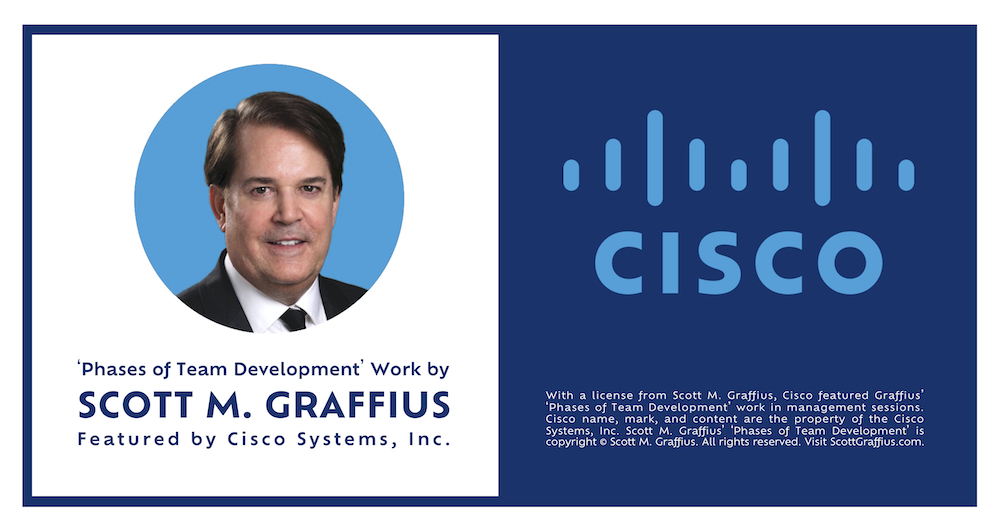










Sign up for Miro—it's free!
(Want more features? You can always upgrade to a paid plan.)




Content Acknowledgements
Names, marks, and content are the property of their respective owners.
Scott M. Graffius’ 'Lifespan (Half-Life) of Social Media Posts: Update for 2025' is copyright © Scott M. Graffius. All rights reserved.

How to Cite This Article
Graffius, Scott M. (2025, January 6). Lifespan (Half-Life) of Social Media Posts: Update for 2025. Available at: https://scottgraffius.com/blog/files/lifespan-halflife-of-social-media-posts-update-for-2025.html.

Digital Object Identifier (DOI)
DOI: 10.13140/RG.2.2.35085.65761

Short Link for Article
The short link for this article is https://bit.ly/life-2025

Copyright
Copyright © Scott M. Graffius. All rights reserved.
Content on this site—including text, images, videos, and data—may not be used for training or input into any artificial intelligence, machine learning, or automatized learning systems, or published, broadcast, rewritten, or redistributed without the express written permission of Scott M. Graffius.
